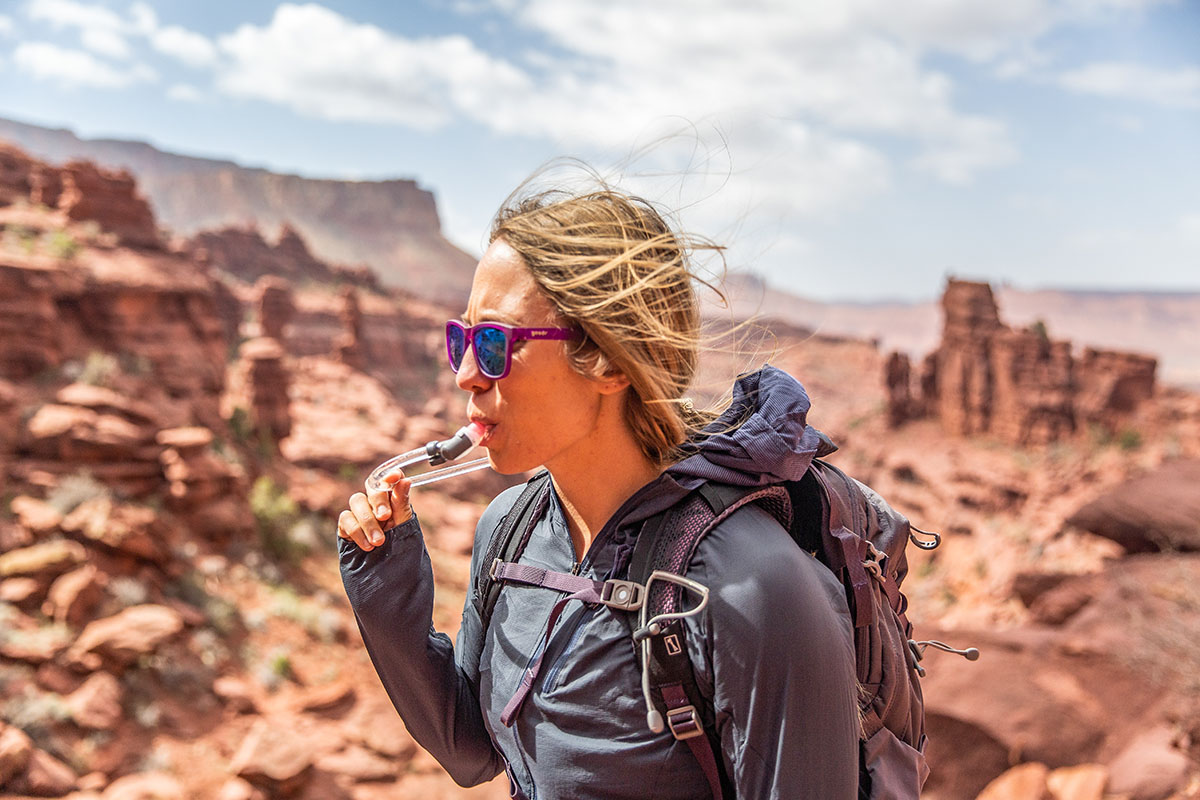
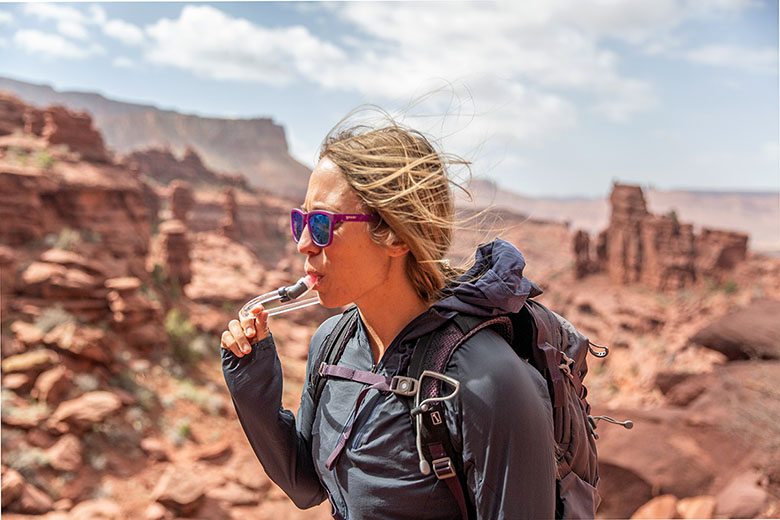
Switchback Travel (Brian McCurdy)
No matter the length or location of your hike, hydration is one of the keys to staying happy and healthy on the trail. There are a number of ways to ensure that you drink enough water throughout the day, but by far the most convenient is a hydration pack. An all-in-one system that includes a sleekly paired daypack and hydration reservoir, a hydration pack makes loading, carrying, and accessing water a breeze. We've been hitting the trails to bring you our favorites since 2022, and below we break down the 14 top hiking hydration packs of 2025, from minimalist vest-inspired models to feature-rich designs that can even accommodate an overnight load. For more information, see our buying advice, comparison table, and testing process details below the picks.
Editor’s note: We updated this guide on June 27, 2025 to add REI’s Swiftland 5 and CamelBak’s HAWG Pro 20 to the list. We also swept the guide to ensure all information was up to date at the time of publishing, which included updating specs and removing discontinued packs.
 Weight: 2 lb. 0.2 oz.
Weight: 2 lb. 0.2 oz.
Capacities: 18, 22, 30L
Included hydration: 2.5L reservoir
What we like: An ideal combination of storage, convenience, and comfort.
What we don’t: Hipbelt pockets are too small; only comes in one size.
There’s no shortage of hydration packs to choose from, but most hikers will benefit from a simple yet functional design that offers ample gear and water storage, a nicely cushioned yet low-profile suspension system, and convenient organization. Our favorite goldilocks models are the men's Osprey Skarab 30 and women’s Skimmer 28: In addition to the spacious main compartment with large bucket-style opening, you get a premium 2.5-liter reservoir, a generously sized accessory pocket, hipbelt pockets, and a front dump pocket for stashing extra layers. The 30-liter and 28-liters versions can easily accommodate a down jacket and shell, snacks for the day, and other essentials, and organization and on-the-go access is well thought-out and convenient. We’ve tested a lot of hydration packs, and in our opinion, the Skarab and Skimmer are the most well-rounded designs for day hikers.
You can go a lot of directions with a hydration pack: Our picks below run the gamut from uber-featured and supportive rigs to stripped-down vests for fast-and-light endeavors. For the standard day hike, many of these packs are too big or too small, too overbuilt or too streamlined. On the other hand, when we put on the Skimmer (which we tested on several day hikes in Moab), it was just right. But we do have a few small gripes: The hipbelt pockets (one zippered, one stretch mesh) don’t accommodate our standard-sized smartphone, and both the Skarab and Skimmer only come in one torso size. But this is a pack that makes hydration easy—just fill up the Osprey Hydraulics LT reservoir, slide it into its pouch behind the backpanel, and hook up the quick-disconnect hose, which routes cleanly through a port and secures via a magnet onto the sternum strap. For an all-in-one solution that’s reasonably priced at $150, it doesn’t get much better—and Osprey offers the pack in three capacities to accommodate all your trail needs.
See the Men's Osprey Skarab 30 See the Women's Osprey Skimmer 28

 Weight: 1 lb. 2.9 oz.
Weight: 1 lb. 2.9 oz.
Capacities: 18, 22L
Included hydration: 3L reservoir
What we like: A versatile and affordable pack with 3 liters of water storage.
What we don’t: Minimal support, capacity, and organization.
For short day hikes, multi-pitch rock climbing, or everyday travel, the Gregory Nano 18 H2O is a high-quality yet affordable offering from a company that knows how to make a solid pack. Value is excellent: For just $90, you get a 3-liter quick-drying 3D Hydro reservoir (a $53 value), along with a lightweight 18-liter pack (available in both regular and plus sizes) that comes with a range of storage and features. Unlike designs with bulkier suspension systems, the Nano is streamlined enough to fit inside a larger pack and pull out for quick summit missions, and it’s versatile too: You can remove the hydration reservoir and fit a 13-inch computer in the rear stash instead. All told, for a minimalist hydration pack that can pull double duty for everyday use, the Nano 18 H2O is our favorite budget offering of 2025.
Keep in mind that for most day hikes, we recommend a bit more capacity, better support, and more organizational features, but the Nano is great for short hikes or adventures that don’t require much gear. That said, if you’re going out for a full day or would rather prioritize a sleek user experience over cost- and weight-savings, we’d stick with a pack like the Skarab above. On the other hand, penny pinchers can Frankenstein their kit together—if you already have a reservoir, you can purchase a pack like the REI Co-op Flash 18 ($40), which is similar to the Nano. Two other light and affordable options to consider are CamelBak’s Hydroback Light (below) and Arete 14, which feature even more stripped-down builds (including no hipbelt) but will appeal to the weight- and price-conscious crowd. But it’s hard to beat the value of the Nano H2O (which also comes in a 22L version), and the all-in-one design certainly adds an extra level of convenience. Note: At the time of publishing, the Nano H20 is REI-exclusive, meaning you won’t find it sold elsewhere (you can still find the bladderless Nano 18 on Gregory’s site for $75).
See the Gregory Nano 18 H2O
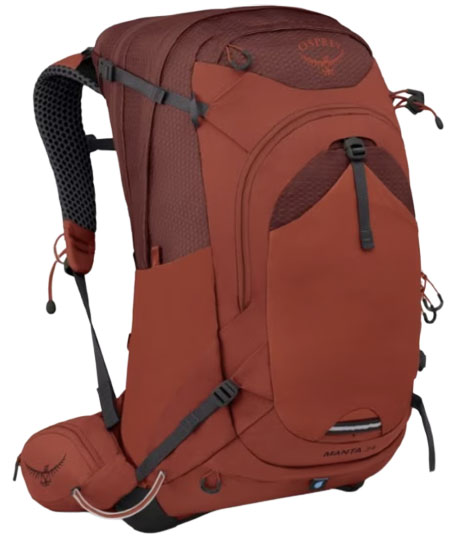 Weight: 3 lb. 7.8 oz.
Weight: 3 lb. 7.8 oz.
Capacities: 24, 34L
Included hydration: 2.5L reservoir
What we like: Metal frame and suspended mesh backpanel offer great support and ventilation.
What we don’t: Overbuilt in terms of both support and features.
Most of the hydration packs here feature fairly stripped-down suspension systems, more reminiscent of barebones daypacks than backpacking packs. But for those who need the extra support, Osprey’s Manta 34 and women’s Mira 32 are a great option. Designed with a metal frame, suspended mesh backpanel (great for ventilation), and generously padded mesh hipbelt and shoulder straps, the Osprey doesn’t hold anything back in terms of comfort and load distribution. Further, while most designs have fixed shoulder straps and offer minimal customization, the Manta’s harness can be adjusted to fit a range of torso lengths. Tack on a full set of features (including a rain cover, trekking pole attachment, gear loops, and two large main compartments) and a 2.5-liter LT reservoir, and it’s the full package for modern hikers who prefer all the bells and whistles.
We tested the 22-liter version of the Mira (the women’s equivalent to the Manta 24) and have mixed reviews: While we can certainly see the appeal of this pack for those who need the extra support, it’s overbuilt in most ways. Even the 22-liter version felt larger than the Osprey Skarab 30 above (you do get compression straps to cinch down a half-full load), and the design is busy and complex, with almost too many compartments to misplace your gear. As a result, unlike the Skarab or Nano above, the bulky Manta is tricky to pack inside another backpack or suitcase while traveling, and most hikers simply don’t need this much structure for 34 liters of capacity. But you won’t find a more comfortable, supportive, and ventilated hydration pack, and Osprey’s reservoirs are well executed and fairly easy to clean.
See the Men's Osprey Manta 34 See the Women's Osprey Mira 32

 Weight: 14.0 oz.
Weight: 14.0 oz.
Capacity: 12L
Included hydration: 1.5L reservoir
What we like: A running vest-inspired design with hiking-ready features and capacity.
What we don’t: Only offered in a single unisex size and uncomfortable when overloaded.
Being able to hydrate without stopping is great for efficiency on the trail, but having access to snacks and other essentials can bring your speed to the next level. Combining the on-the-go storage of a running vest with a nice array of hiking-friendly features, the Nathan TrailMix is a great tool for the job. At the back, you get a streamlined main compartment, including a sleeve and hanger for the 1.5-liter HydraPak reservoir, along with a mesh shove-it pocket for stashing extra layers, a practical bungee system for securing gear externally, and a handy roll-top closure that allows you to compress or expand the opening depending on your load. Four vest-style pockets flank the front and make it easy to divvy up essentials like a phone, bars, sunglasses, or soft flasks up to 20 ounces (sold separately). Like most vests, the TrailMix rides high on the torso and forgoes a hipbelt, but underarm adjustments and two sternum straps effectively cinch the load close to your body—great for minimizing bounce while moving quickly on the trail.
What complaints do we have about the Nathan TrailMix 2.0? First is the 12-liter capacity, which is one of the smallest here and limiting for longer and more gear-intensive day hikes. The lack of hipbelt doesn’t help, requiring you to keep your load fairly light to avoid discomfort along the shoulders. We also wish Nathan had included at least one zippered pocket along the front for added security when stashing valuables, although we haven’t had any issues with our phone popping out on runs. Finally, the design is only offered in a single unisex size, which fits our 5’6” female tester nicely but won’t work for everyone (it’s a good item to try on before you buy). Within this category, it’s also worth considering the Osprey Duro 15, which is a little more pack-like than the TrailMix—including a storage-equipped hipbelt—but pricier at $165 and considerably heavier (1 lb. 10.6 oz. for the S/M size). In the end, we think the TrailMix strikes a hard-to-beat balance, with great on-the-go access and versatility for hikers and runners alike.
See the Nathan TrailMix 2.0 12L
 Weight: 14.9 oz.
Weight: 14.9 oz.
Capacities: 4, 7L
Included hydration: 1.5L reservoir
What we like: A lightweight and low-profile alternative to standard packs for short hikes and bike rides.
What we don’t: Limited capacity and water storage for full days out.
Hydration-equipped waist packs are becoming increasingly popular among mountain bikers and runners, and the allure is clear: In addition to providing a lighter and lower-profile storage solution than standard packs can offer, these designs keep your back free to breathe and concentrate the weight on your hips rather than your shoulders to maximize all-day comfort. While technically designed for biking, Osprey’s Seral 4 makes for a great hiking companion with a streamlined and body-hugging shape, the brand’s proven AirScape backpanel that provides good support and keeps air moving, and a premium Hydraulics reservoir that’s shaped to fit neatly inside the main compartment. For short hikes, bike rides, or runs, the Seral is an intriguing and fully workable alternative to the standard hydration packs here.
What do you sacrifice by opting for a waist pack like the Osprey Seral 4? In addition to offering limited capacity and water storage for full days out, the Seral includes some bike-specific features that may not prove useful to hikers who don’t spend time on two wheels, including a blinker light attachment and dedicated tool organization inside the main compartment. To be fair, these are integrated very nicely into the design, and the tool space works equally well for stashing smaller items (e.g., lip balm and a bar) and valuables. From a value standpoint, the Seral is relatively pricey for what you get at $90—you can get considerably more space for less with the Gregory Nano 18 above, for example—but it’s a quality design that’s built to last.
See the Osprey Seral 4
 Weight: 1 lb. 11.7 oz.
Weight: 1 lb. 11.7 oz.
Capacities: 18, 24L
Included hydration: 2L reservoir
What we like: Great storage and a hydration pocket that doubles as a laptop sleeve.
What we don’t: We prefer the 30-liter capacity of the Skarab above.
The Osprey Skarab 30 and Skimmer 28 are our favorite all-around hydration pack for day hikers, but Gregory’s Inertia 24 and women’s Swift 22 H2O aren't far behind. A similarly minded design, the Inertia and Swift balance comfort and organization with a relatively streamlined suspension system and feature set. Water is easy to load with a dedicated reservoir pocket (which doubles as a laptop sleeve), convenient hanging clip, and easy-to-access quick-disconnect. And like the Osprey, the Gregory Intertia and Swift feature padded mesh backpanels, shoulder straps, and hipbelts. Storage is also on par, too, including a zippered accessory pocket, side pockets, hipbelt pockets, and a front bungee. Added up, the Inertia is a user-friendly hydration pack that will suit the needs of most casual day hikers.
The Inertia gives the Skarab a run for its money as our favorite hydration pack of the year, but we rank it below for a few reasons. First, while the 24-liter design gets the job done for mild-weather hiking with minimal gear, we prefer the Skarab’s 30-liter capacity for year-round use or if we want to carry a little extra (like a full-frame camera or camping blanket). Second, we have a slight preference for the Osprey’s hydration reservoir, which has a wide opening for easy cleaning and drying (Gregory’s 3D Hydro’s small opening can make cleaning more difficult, although the integrated hanger and shape-holding design does help with drying). And finally, while the Skarab’s bucket-style opening offers great access to the main compartment, the Interia’s traditional U-shaped zipper is a bit more limited. But for an attractive hydration pack that falls between the Skarab 30 and Skarab 22 ($130) in terms of capacity, the Inertia 24 is a nice option for both hiking and everyday use.
See the Men's Gregory Inertia 24 H2O See the Women's Gregory Swift 22 H2O
 Weight: 1 lb. 15.0 oz.
Weight: 1 lb. 15.0 oz.
Capacities: 12, 16, 22L
Included hydration: 2L reservoir
What we like: On-the-go storage combined with the added support of a cushioned hipbelt.
What we don’t: Only comes in one size.
The Nathan TrailMix 2.0 12L above is a great option for short jaunts or carrying minimal gear, but for high-mileage days or cold weather (when you might need a lot of layers), it’s nice to have a bit more capacity. CamelBak’s Octane 22 combines the on-the-go storage of the TrailMix with a 22-liter design, adding on a large zippered entry to the main compartment and a cushioned hipbelt (with pockets) to help distribute the weight of larger loads. The hybrid pack comes complete with a 2-liter Fusion reservoir, a zippered chest pocket, and an integrated rain cover. It all adds up to a well-rounded yet minimalist design for hikers who like to move quickly or mix in the odd bit of running.
Our biggest gripe with the Octane 22 is that it only comes in one size. This is a major shortcoming of hydration packs in general, but vest-style designs in particular can really benefit from a more tailored fit (many running vests come in five sizes). It’s also important to note that, despite the brand’s prominence in the world of on-the-go hydration, CamelBak’s packs don’t often match the quality and fit of models from specialists like Osprey and Gregory. But the Octane (which also comes in 12L and 16L versions) is nevertheless a thoughtfully designed vest/pack that offers much better gear access than most of the competition.
See the CamelBak Octane 22
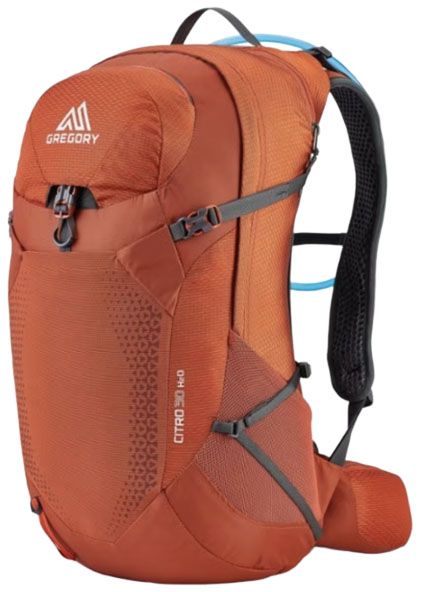 Weight: 2 lb. 1.4 oz.
Weight: 2 lb. 1.4 oz.
Capacities: 24, 30L
Included hydration: 3L reservoir
What we like: A toned-down alternative to the Manta above.
What we don’t: Non-adjustable backpanel; hipbelt pockets are too small for an average-sized smartphone.
Osprey and Gregory often go head-to-head in the pack market, and Gregory’s answer to the Manta and Mira above is the Citro and women’s Juno 30. With an alloy frame, generous padding, and an airy mesh backpanel, the Citro does a great job distributing a heavy load and eliminates the sagging or pressure points you might get from less structured designs like the Skarab or Inertia above. But unlike the Manta, its layout is featured without verging on overkill: For over a pound less, the Citro still has a range of storage, including a main compartment, generous accessory pocket with scratch-free liner, front and side dump pockets, hipbelt pockets (too small for our smartphone, unfortunately), and a dedicated zippered pocket for the included 3-liter reservoir. For a nice middle ground between the Osprey Skarab and Manta packs above, we really like the Citro.
Compared to the Skarab, the Citro is heavier and $30 pricier but offers slightly more organizational options, along with significantly more structure and support. We prefer the more streamlined backpanel of the Osprey, but if you tend to pack bulky items or carry a lot of gear, the Gregory certainly has its place. On the other hand, it doesn’t quite measure up to the Manta in terms of support, nor do its fixed shoulder straps adjust to accommodate different torso lengths (note: the Citro and Juno 30 do come in plus size options, but they unfortunately cost $20 more than the standard size). But for $40 less, the Citro is a well-rounded pack that offers more than enough carrying comfort for most hikers without feeling too over the top. And as with Gregory’s Nano and Inertia above, we appreciate the 3D Hydro reservoir, which is easy to load, routes cleanly through a hose clip and magnetic buckle, and features a quick-drying design.
See the Men's Gregory Citro 30 H2O See the Women's Gregory Juno 30 H2O
 Weight: 1 lb. 8.0 oz.
Weight: 1 lb. 8.0 oz.
Capacities: 22, 30L
Included hydration: 1.5L reservoir
What we like: Comfortable carry and a lot of organizational options for the price.
What we don’t: Middling quality; we have mixed feelings about CamelBak’s recent updates.
For short day hikes or minimalist outings with a light load, CamelBak’s Rim Runner X22 is a functional and lightweight offering for just $116. Along with a 1.5-liter Crux reservoir, you get a generous amount of organization, including a small zippered pocket on the left shoulder strap, three large external dump pockets (we’ve found these to be very useful for stashing items on the go), and a couple zippered accessory pockets both inside and out. Like the Osprey Skarab above, the Rim Runner features a bucket-style opening to the main compartment, making it easy to see and access items at the bottom of your pack. The most recent version of the pack also utilizes recycled materials and features a detachable hipbelt, which is a nice option to have on short outings with minimal gear.
All told, the RimRunner is certainly a step up from a daypack like the Gregory Nano 18 above in terms of organization and comfort, but it falls short of more all-around offerings like the Osprey Skarab and Gregory Inertia. We’re also a bit mixed on CamelBak’s recent updates to the design: The hipbelt is no longer generously cushioned, organization is more streamlined with no hipbelt pockets and one less dump pocket along the exterior, and CamelBak now includes a 1.5-liter (rather than 2L) reservoir. Finally, it’s worth mentioning that for $14 more, you can bump up to the 22-liter version of the aforementioned Skarab, which features a larger reservoir (2.5L), along with a higher-quality design—although you do give up the Rim Runner’s front dump pocket, which we love for quickly stashing an extra layer.
See the Men's CamelBak Rim Runner X22 See the Women's CamelBak Rim Runner X20
 Weight: 9.0
Weight: 9.0
Capacity: 5L
Included hydration: 1.5L reservoir
What we like: A great combination of running vest and hiking pack; comes in a wide range of sizes.
What we don’t: Small capacity and lack of technical features are limiting.
Like Nathan’s TrailMix above, REI’s Swiftland 5 strikes a nice balance between running vest and hiking pack. The large main compartment is complemented with a nice array of smaller internal and external pockets, including 5 pockets along the front that can be used to store snacks, an iPhone, or soft flasks (sold separately). Plus, a stretchy mesh stuff pocket on the back easily accommodates a windbreaker when the going gets hot. REI includes a 1.5-liter reservoir which has a hose that routes along the chest when not in use. And unlike the TrailMix, the Swiftland comes in three sizes, including a XXL/XXXL size. We found the side compression straps and two sternum straps easy to adjust, and the pack remains comfortable even when fully-loaded.
That said, it is easy to fully load this pack: With just 5 liters of carrying capacity, the Swiftland 5 is even more limiting than the TrailMix (which has a 12L capacity). It also lacks some finer technical details, like a hiking pole carry system (the TrailMix has a bungee system that gets the job done). REI’s Swiftland TT—which stands for “technical terrain”—is a viable alternative if you’re looking for a bit more capacity and features. This 7-liter pack has two zippered chest pockets, bungees on the back for carrying hiking poles, and an InReach-compatible pocket along the shoulder. Though, it costs $30 more than the Swiftland 5 and doesn’t come with a reservoir (it is reservoir-compatible and comes with 2 500ml HydraPak soft flasks). While the TrailMix is a better choice for more technical outings, the Swiftland 5 has proved a reliable companion for day hikes on groomed trails and, of course, the occasional run.
See the Men's REI Co-op Swiftland 5 See the Women's REI Co-op Swiftland 5
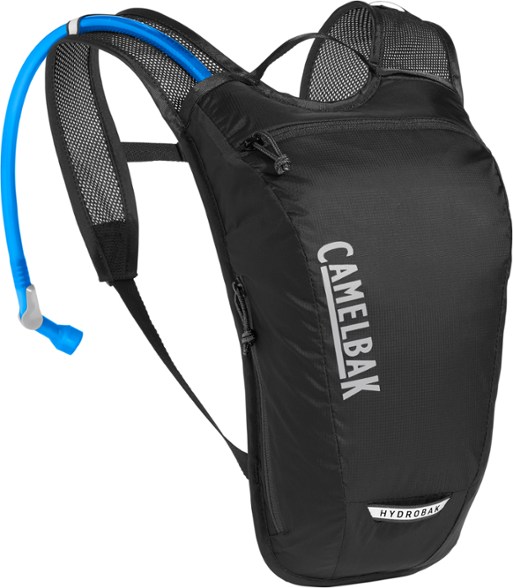 Weight: 6.0 oz.
Weight: 6.0 oz.
Capacity: 1L
Included hydration: 1.5L reservoir
What we like: The cheapest and lightest option on our list.
What we don’t: Decidedly minimalist capacity, feature set, and build.
Gregory’s Nano 18 H2O above is our favorite budget/ultralight design of the year, but CamelBak makes another surprisingly affordable and lightweight option in their Hydrobak Light. At just $72 and a scant 6 ounces, the Hydrobak is both the cheapest and lightest option on our list, undercutting the Gregory by $18 and over 12 ounces. As we’ve come to expect from CamelBak, the pack is also well built with good padding along the backpanel and plenty of mesh along the shoulder straps to keep you cool when working hard. Finally, like Nathan TrailMix 2.0 and REI Swiftland 5 above, the Hydrobak has a low-profile feel and body-hugging fit that make it easy to move quickly whether you’re running, biking, or tackling a steep section of trail.
The most glaring downside to the Hydrobak Light is its meager 1-liter gear capacity, which is the smallest on our list and decidedly limited for long day hikes that require packing plenty of water and layers. The included 1.5-liter reservoir is also on the smaller end, and you forgo comfort-related features like a hipbelt and padded shoulder straps (the Hydrobak’s are made of thin mesh to keep weight low). Finally, the Hydrobak is more biking-focused than many options here, including dedicated tool storage, a loop for securing a light (sold separately), and an external helmet carry system. But this may be an upside for some: The CamelBak makes a great mountain biking companion but crosses over nicely for running and hiking (the low-profile fit even makes it viable as a kids’ pack), offering an all-in-one solution for those who like to do it all. For a more hiking-specific option, CamelBak’s own Arete 14 costs the same as the Hydrobak but with 12.5 liters of capacity in a heavier (9.0 oz.) package.
See the CamelBak Hydrobak Light
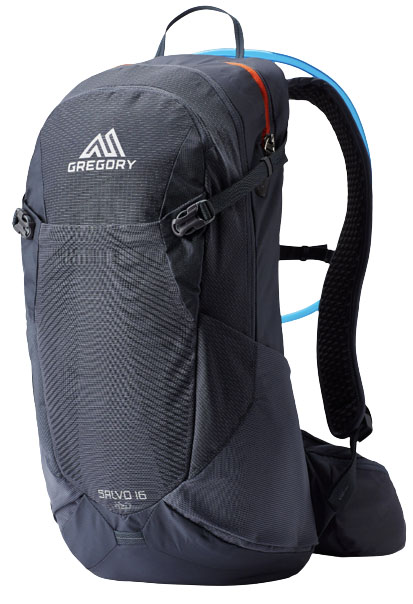 Weight: 1 lb. 13.1 oz.
Weight: 1 lb. 13.1 oz.
Capacities: 8, 16L
Included hydration: 3L reservoir
What we like: A small-capacity pack with a big-deal feature set.
What we don’t: Expensive for the capacity.
Smaller-capacity hydration packs often correlate with barebones builds, as seen in designs like the Gregory Nano above. But Gregory’s Salvo and women’s Sula offer different takes for hikers who want all the bells and whistles without the added storage space. With just 16 liters of capacity (the packs are also available in an 8L versions), the Salvo and Sula accommodate only the essentials, but with the same levels of ventilation, support, and organization we see in much larger packs. A suspended mesh backpanel and 3-liter reservoir headline the long list of features, making the Salvo a great choice for staying breezy and hydrated in hot conditions.
The Salvo and aforementioned Nano are both ideal for summer hikes where you don’t need much more than water, snacks, and an extra layer, but what sets them apart from each other? Along with the ventilated backpanel, the most notable difference is the Salvo’s hipbelt, which offers significant support (especially compared to the Nano’s simple webbing belt), along with two smartphone-sized pockets (rejoice!). The Salvo also features a handy stretch-mesh dump pocket at the front, along with a soft internal pocket for safe-keeping of fragile items. You’ll pay a premium for the additional features—the Salvo is $70 more than the Nano and $10 more than our top-ranked 30-liter Skarab—but the combination of minimum capacity and maximum performance will be a match made in heaven for some.
See the Men's Gregory Salvo 16 H2O See the Women's Gregory Sula 16 H2O
 Weight: 2 lb. 14.0 oz.
Weight: 2 lb. 14.0 oz.
Capacities: 20L
Included hydration: 3L reservoir
What we like: A hike/bike crossover pack and plenty of organization.
What we don’t: Heavy, expensive, and overbuilt for most outings; no women’s specific version.
CamelBak’s HAWG (which stands for “Holds A lotta Water and Gear”) is a popular pack among mountain bikers, but it has a lot of appeal in the day hiking sphere as well. With 20-liters of carrying capacity, the HAWG offers plenty of room for layers, snacks, and valuables, with a plethora of internal and external pockets to keep it all organized—the main dump pocket easily swallows jackets, the hipbelt pockets can hold an iPhone, and small internal pockets are ideal for keys, wallets, and small gear (we especially like the soft lined pocket for storing our sunglasses). The 3-liter reservoir can be filled without removing it from the pack—thanks to the gaping main compartment—and the magnetic tube trap keeps the hose secure to the shoulder straps when not in use. The design is rounded out nicely with a body-mapped backpanel that uses mesh in sweat-prone areas and hard-wearing 420-denier nylon face fabric that’s reinforced with a PFAS-free durable water repellent (DWR) that will keep your gear dry in the off chance you get caught out in a storm.
The HAWG also comes with an assortment of bike-specific features, such as a helmet carry, integrated tool roll, impact protector compatibility, and e-bike battery sleeve. But while its technical appeal is nice for those looking for a do-it-all pack for biking and hiking outings, it’s overbuilt for the average day hike. The maximalist feature set doesn't help the price and weight of the HAWG either, which come in at a hefty $170 and 2 pounds 14 ounces respectively. We’d sooner reach for the Skarab above which has a larger—albeit more streamlined—capacity, lighter weight, and smaller price tag. And, as a final note, the HAWG doesn’t come in men’s and women’s-specific sizing, and female hikers with short torsos have reported some discomfort. That said, if you’re on the hunt for a hydration pack that can keep up in technical treks, the HAWG is hard to beat.
See the CamelBak HAWG Pro 20
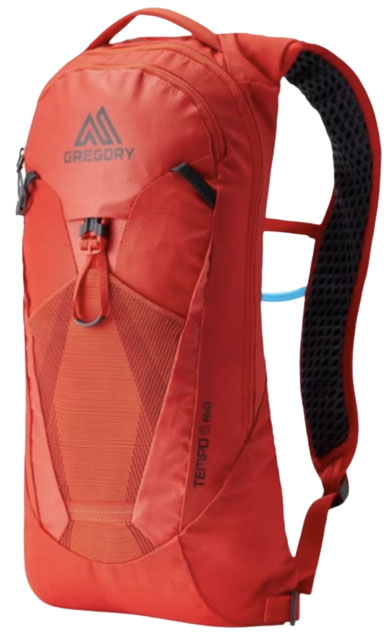 Weight: 1 lb. 5.4 oz.
Weight: 1 lb. 5.4 oz.
Capacities: 6L
Included hydration: 2L reservoir
What we like: Keeps your water cold for up to four hours.
What we don’t: Not much in the way of organization.
If you’re hiking in extreme temperatures, it’s worth thinking about insulating your water against the elements. There are a few ways to do this: You can purchase an insulated hydration reservoir (the HydraPak HydraSleeve is one example) or opt for an insulated hydration pack like the Gregory Tempo and women's Pace here. The Tempo and Pace are built for heat (Gregory claims they will keep your water cool for four hours), with insulated hydration compartments and breathable 3D mesh backpanels and shoulder harnesses. The rest of the design is kept very minimalist, with a thin webbing hipbelt, small zippered accessory pocket, and stretch-mesh dump pocket on the rear.
But aside from being able to keep your water cold for a short time—great, for example, if you’re going on a half-day hike straight from home—the Tempo and Pace don’t have too much going for them. The 6-liter designs are oversimplified for most day hikes, with enough space for just a wallet, keys, and small snack (we couldn’t even fit a lightweight down jacket inside). Further, the drinking hose is not insulated, which slightly compromises the insulating concept. But the Tempo and Pace are nevertheless nice options for particularly hot climates, and their sleek designs also have great crossover appeal for biking.
See the Men's Gregory Tempo 6 H2O See the Women's Gregory Pace 6 H2O
| Hydration Pack | Price | Weight | Capacities | Hydration | Hipbelt |
|---|---|---|---|---|---|
| Osprey Skarab 30 | $150 | 2 lb. 0.2 oz. | 18, 22, 30L | 2.5L reservoir | Cushioned |
| Gregory Nano 18 H2O | $90 | 1 lb. 2.9 oz. | 18, 22L | 3L reservoir | Webbing |
| Osprey Manta 34 | $220 | 3 lb. 7.8 oz. | 24, 34L | 2.5L reservoir | Cushioned |
| Nathan TrailMix 2.0 12L | $160 | 14.0 oz. | 12L | 1.5L reservoir | None |
| Osprey Seral 4 | $90 | 14.9 oz. | 4, 7L | 1.5L reservoir | Cushioned |
| Gregory Inertia 24 H2O | $140 | 1 lb. 11.2 oz. | 18, 24L | 2L reservoir | Cushioned |
| CamelBak Octane 22 | $186 | 1 lb. 15.0 oz. | 12, 16, 22L | 2L reservoir | Cushioned |
| Gregory Citro 30 H2O | $180 | 2 lb. 1.4 oz. | 24, 30L | 3L reservoir | Cushioned |
| CamelBak Rim Runner X22 | $116 | 1 lb. 8.0 oz. | 22, 30L | 1.5L reservoir | Webbing |
| REI Co-op Swiftland 5 | $100 | 9.0 oz. | 5L | 1.5L reservoir | None |
| CamelBak Hydrobak Light | $72 | 6.0 oz. | 1L | 1.5L reservoir | None |
| Gregory Salvo 16 H2O | $160 | 1 lb. 13.1 oz. | 8, 16L | 3L reservoir | Cushioned |
| CamelBak HAWG Pro 20 | $170 | 2 lb. 14.0 oz. | 20L | 3L reservoir | Cushioned |
| Gregory Tempo 6 H2O | $120 | 1 lb. 4.8 oz. | 6L | 2L reservoir | Webbing |
No matter your hiking objective—be that busting trail to the top of a mountain or stretching your legs on a casual jaunt close to home—staying hydrated is key to an enjoyable outing. At the end of the day, a good hydration pack should do three things: provide quick and easy access to water (via a hydration bladder), hold all of your essential gear, and carry comfortably. With those considerations in mind, former senior editor Jenny Abegg debuted this list in 2022 with 12 quality packs. An accomplished mountain athlete and ultrarunner, Jenny knows the importance of proper nutrition and hydration during long efforts, whether she’s hiking in to bivy at the base of a Patagonia peak or completing high, technical traverses in the North Cascades. Editor Maddie Downie took over the list in 2024, expanding it to the 14 picks you see above. Maddie grew up hiking in the high and dry Colorado Rockies and now spends most weekends bagging peaks in northern Washington.
We take several factors into account when testing and evaluating hydration packs. Capacity needs will vary depending on your objective(s), and our list above reflects the varying needs of hikers from fast-and-light enthusiasts to comfort-focused hikers who put a premium on support. Since the included reservoir is a key reason many people opt for a hydration pack in the first place, we also take a close look at each bladder’s design, including overall ease of use and the quality of each component (if you already own a bladder, check our our picks for the best daypacks). Other considerations we take into account include weight, backpanel design, organization layout, carrying comfort, and fit. Given the dynamic nature of the hydration pack market, we’re constantly putting new and noteworthy designs to the test and will continue revising the list above to bring you our favorites.

Staying hydrated is essential to being alert and limber on the trail, and nothing makes the process easier than a hydration pack. These relatively inexpensive pieces of gear come ready to go, including a daypack and integrated hydration bladder—all you need to do is add water. There are a vast array of hydration packs to choose from for a variety of activities—including biking, running, snow sports, and more—but here we focus on designs specifically built for hiking. Below we break down the category, including the various backpack features, hydration reservoirs and compatibility, and more.
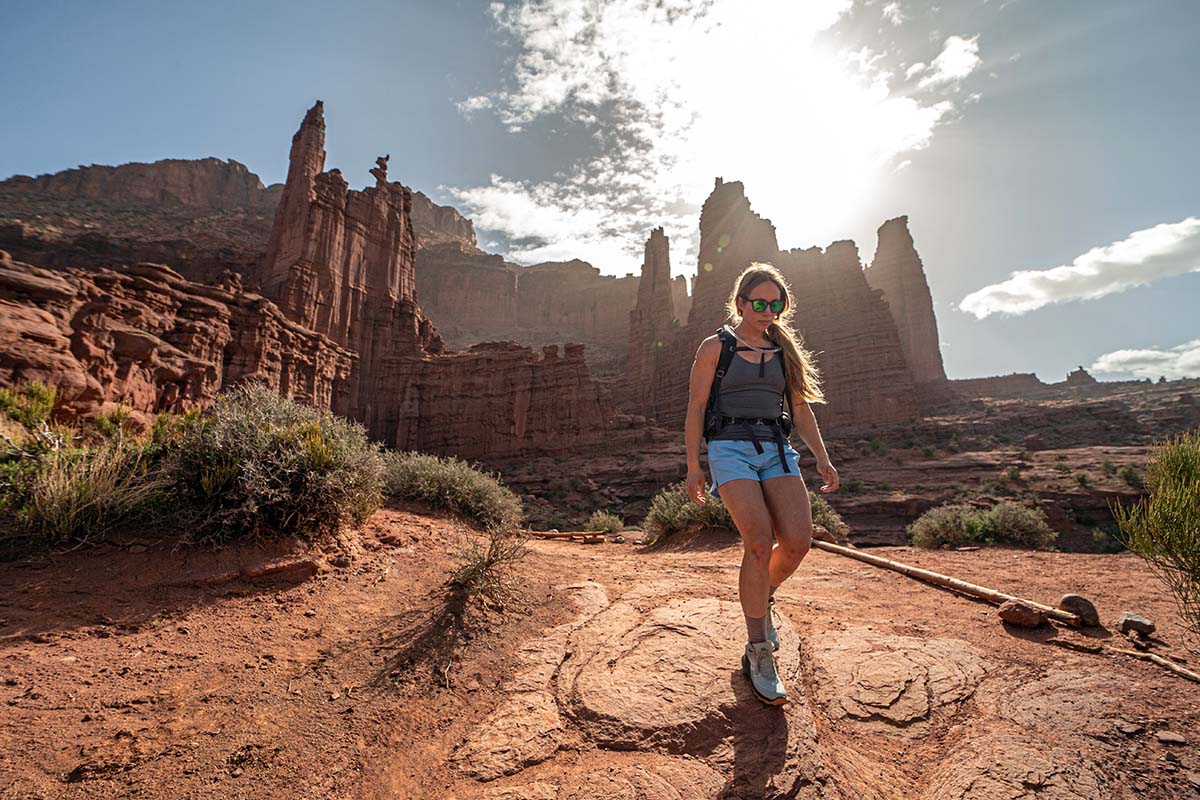
Hydration Packs vs. Hydration-Compatible Backpacks
In this article, we focus on backpacks that come complete with an integrated hydration reservoir (and in one case, a soft flask). These are the most purpose-built setups for on-trail hydration and the most convenient for those just getting started—the reservoir fits seamlessly (sometimes in its own dedicated pocket), the tube routes cleanly, and many use magnetic attachments to keep the bite valve in place on the sternum strap. If you don’t yet own a daypack or hydration bladder and are in need of an all-in-one solution, there’s no better option.
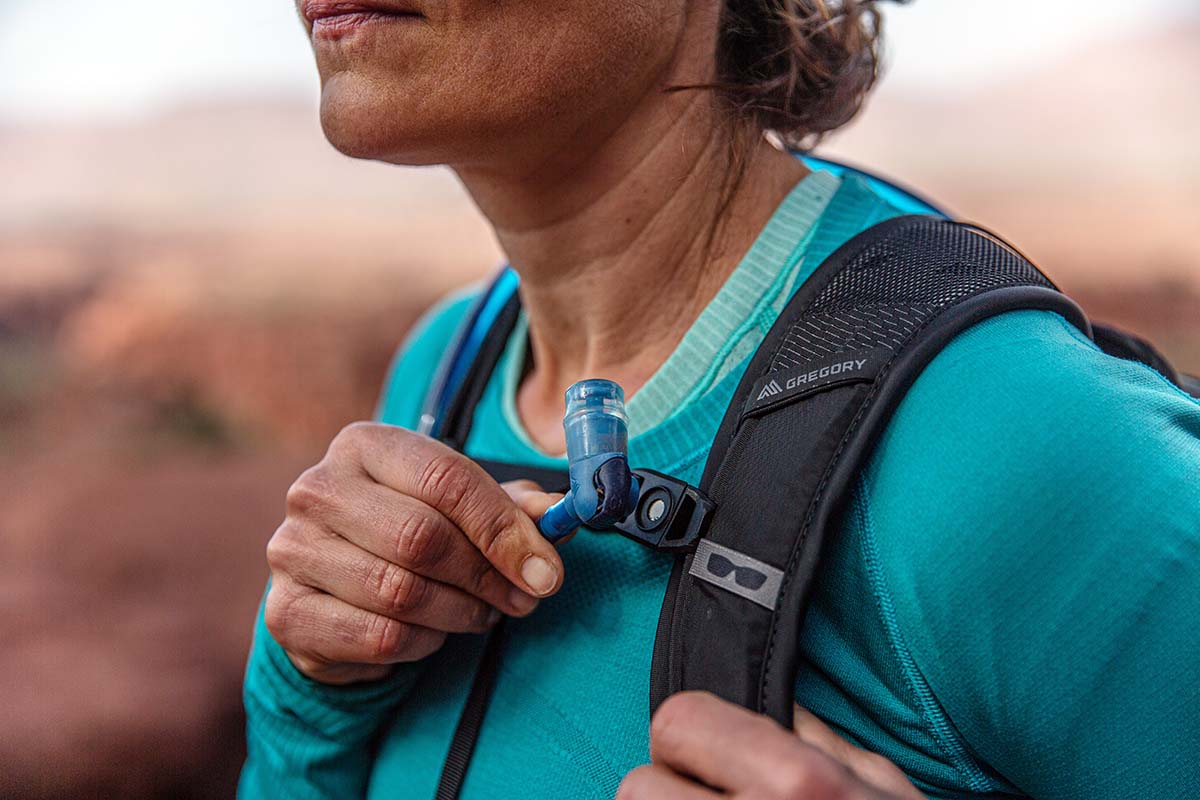
However, there are other ways to achieve the same end result. In 2025, most daypacks (like the popular Osprey Talon 22 and women’s Tempest 22) are hydration-compatible, featuring dedicated reservoir sleeves, ports, and routing clips. Some hydration reservoirs even come complete with tube magnets to attach to your pack. It’s generally a bit cheaper to purchase an all-in-one setup, but if you already own a daypack or reservoir, it might be worth considering buying the accompanying piece separately—just bear in mind that you might have to purchase a few accessories to achieve the same sleek design of an all-in-one hydration pack.
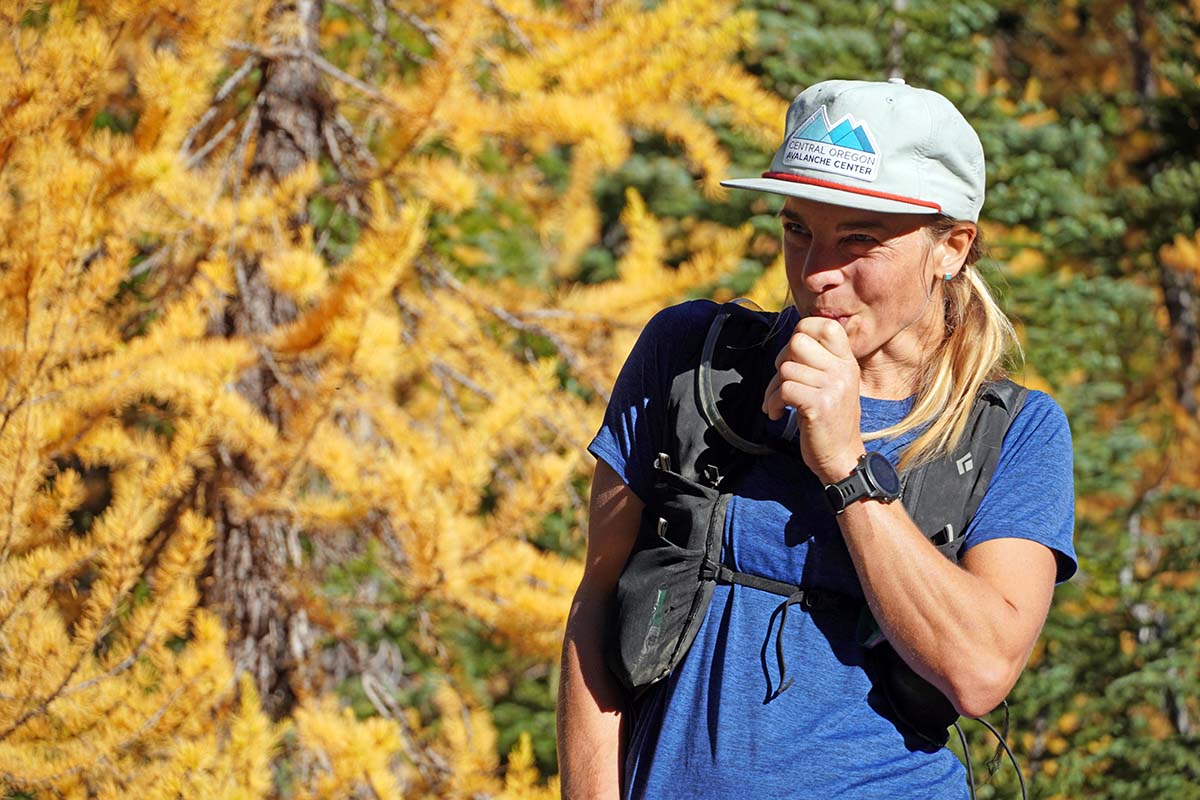
Capacities
Most hydration reservoirs range in capacity from 1.5 to 3 liters, including 2- and 2.5-liter options. Your water needs will depend on a wide range of factors, including your personal makeup (do you sweat a lot or a little, how much water does your body tend to need, etc.?), the conditions you encounter while hiking (hot and sunny or cold and shady?), the length of your trip, the presence of water on-route, and whether or not you're traveling with a water filter. It doesn’t hurt to err on the side of more capacity than less—the weight difference between a 1.5 and 3-liter reservoir is negligible, and you can always fill it halfway.
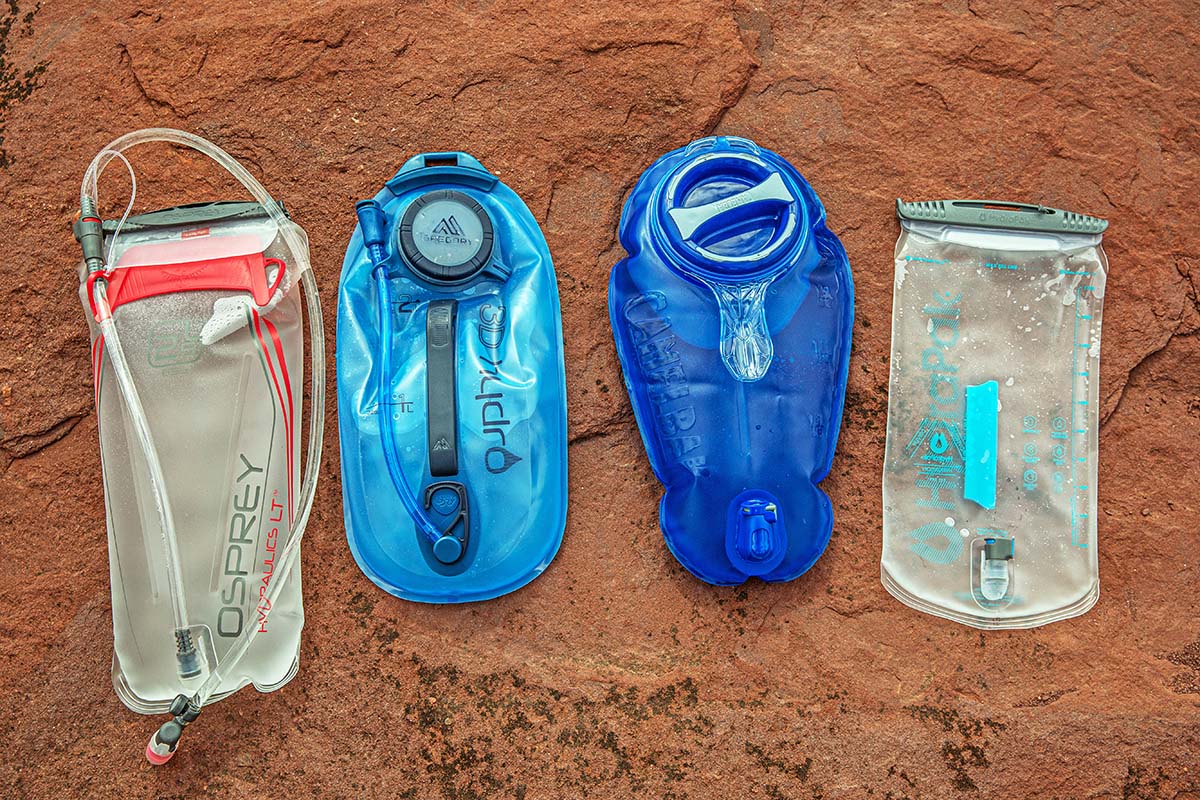
Openings and Handles
In general, there are two main styles of hydration reservoirs—those that feature a top opening that folds over and seals with a slider (Osprey, HydraPak, and Platypus), and those with a circular screw-top port on the front (CamelBak and Gregory). Both are time-tested designs, but differ slightly in terms of functionality. In general, we find top-opening reservoirs to be easier to clean and dry—the mouths are wide enough to fit your hand in, and some offerings from HydraPak can even be turned inside out. On the other hand, with a screw-top like Gregory’s 3D Hydro Reservoir, you likely won’t even be able to get your hand inside (CamelBak’s mouths are a lot wider). There are a lot of ways to clean a hydration reservoir (including cleaning tabs, scrub brushes, drying racks, etc.), but the larger opening and invertible design certainly makes things easier.
On the other hand, screw-top reservoirs can be a lot easier to fill. For example, we were able to replenish our Gregory Pace 6 H2O without removing the reservoir from the pack, but had to take the Osprey Skimmer’s HydraPak out of its sleeve to fill. Of course, this all depends on your water source—if you’re scooping from a lake or river, you’ll want to remove your reservoir regardless, in order to keep your pack from getting wet. Further, most reservoirs (including both screw-top and slider varieties) now feature handles on the top to leverage the opening and make the filling process even easier. In the end, most openings are well executed—no matter the style—but your preferences in terms of filling and cleaning/drying might help inform your purchase.
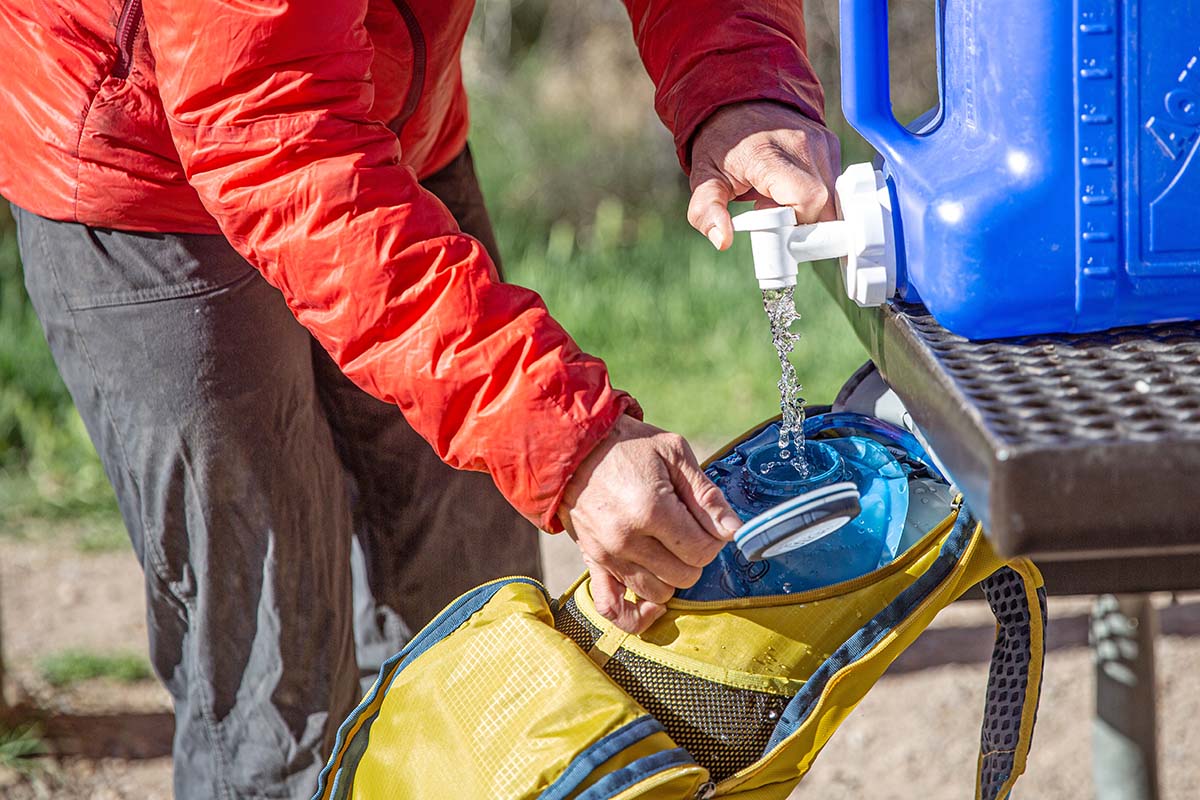
Quick-Disconnect Tubing
When it comes to hydration reservoirs, one of the features we can’t live without is a quick-disconnect coupling on the tube. Placed either where the tube meets the reservoir (as in the case of CamelBak’s designs) or in-line near the top of the reservoir (as with Gregory and Osprey’s offerings), the quick-disconnect removes the tube with the simple push of a toggle. This allows for easy filling or cleaning of the reservoir without a long tube in the way, and eliminates the headache of rerouting the tube through the backpack port and shoulder harness. Virtually all of the designs above feature quick-disconnect tubing, and we have a slight preference for those with a higher placement (i.e., those from Osprey and Gregory), as they’re easier to reconnect once back in your pack (you don’t have to go digging around at the reservoir’s base).
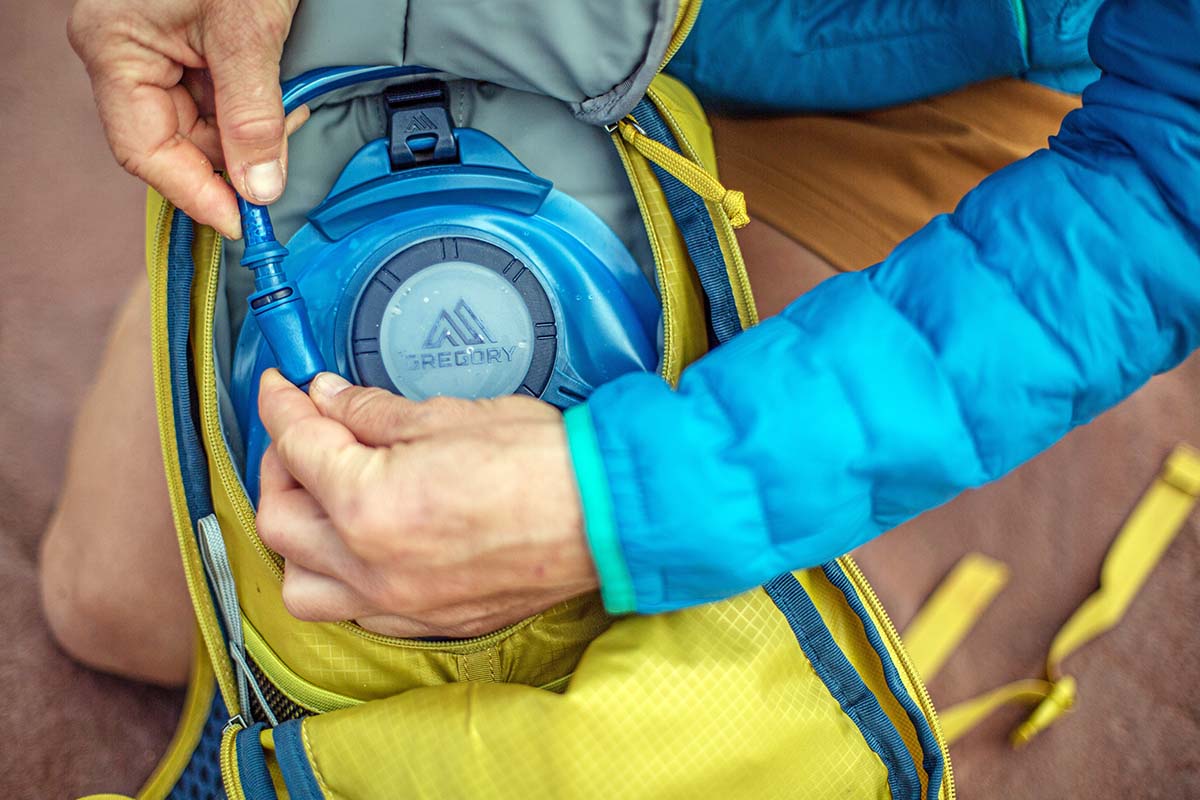
Bite Valves
Each brand of hydration reservoir has its own style of bite valve, including unique on/off mechanisms. Most bite valves are very easy to use—gently compress and water will flow—and can be easily removed and replaced. The largest variation comes in terms of on/off mechanisms: Gregory uses a push button, CamelBak’s offerings feature a large lever, and Osprey’s and REI’s HydraPak designs twist open and closed. We’ve found all of these bite valves to be fairly easy to use and leak-free, although CamelBak’s seem to require the least amount of suction, which is certainly a bonus (they claim their new Crux reservoirs offer 20% more water per sip, which lines up with our experience). On the other hand, the valves found on Gregory’s hydration reservoirs are functional and secure, but their smaller “button” is a bit more difficult to operate.
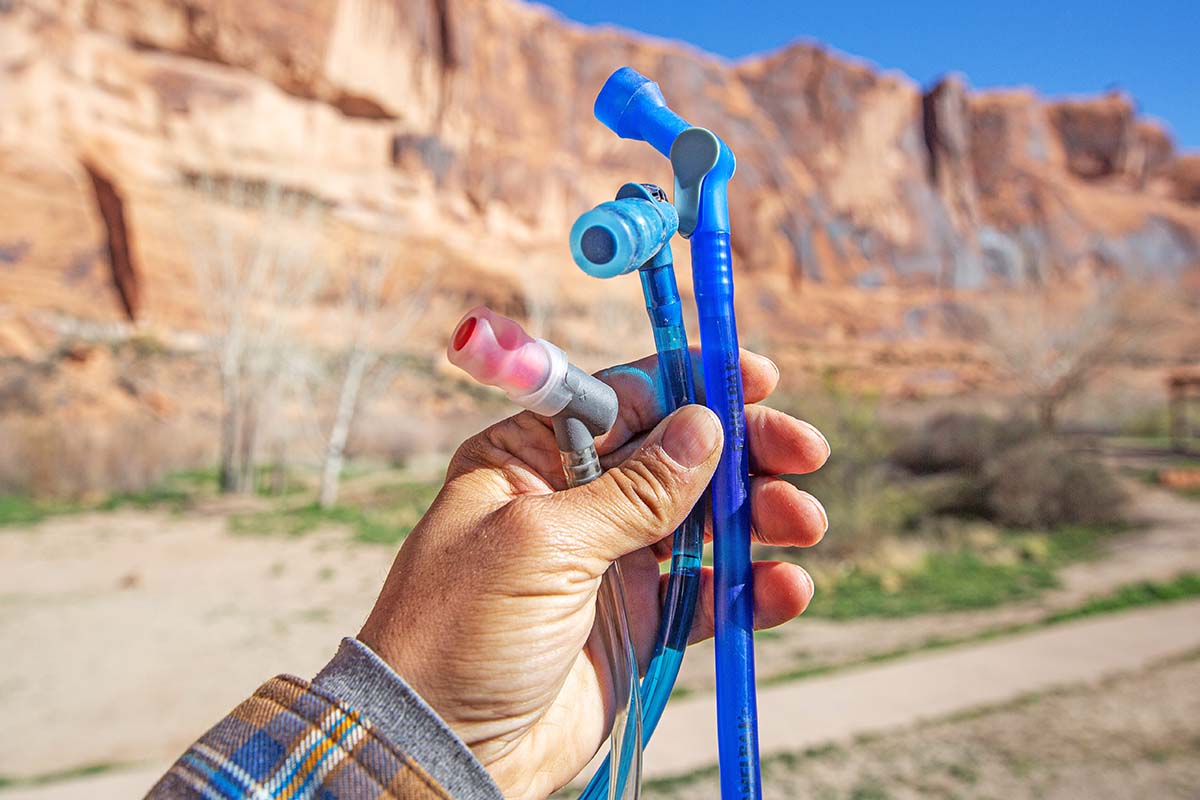
Cleaning a Hydration Reservoir
Let's be honest: cleaning a hydration reservoir isn't our idea of a good time. That said, proper cleaning—and drying—is fairly important to extending the lifespan of your bladder and tube, especially if you're using sticky electrolyte tabs or powder. The good news is that most designs now come with a range of features to help. Gregory's 3D Hydro reservoirs, for example, have an integrated hanger and open design when resting (i.e., they don't lie completely flat), both of which assist in drying. As we mentioned above, CamelBak's Crux reservoirs have a wide, circular opening that's large enough to fit a hand inside. And finally, some HydraPak reservoirs can be turned inside out for quick cleaning and drying. And manufacturers offer a range of other products to help with the process: The Osprey Hydraulics Cleaning Kit, for example, includes a reservoir brush, hose brush, and drying rack, and cleaning tabs (like those from Bottle Bright) are a great way to easily remove build-up.
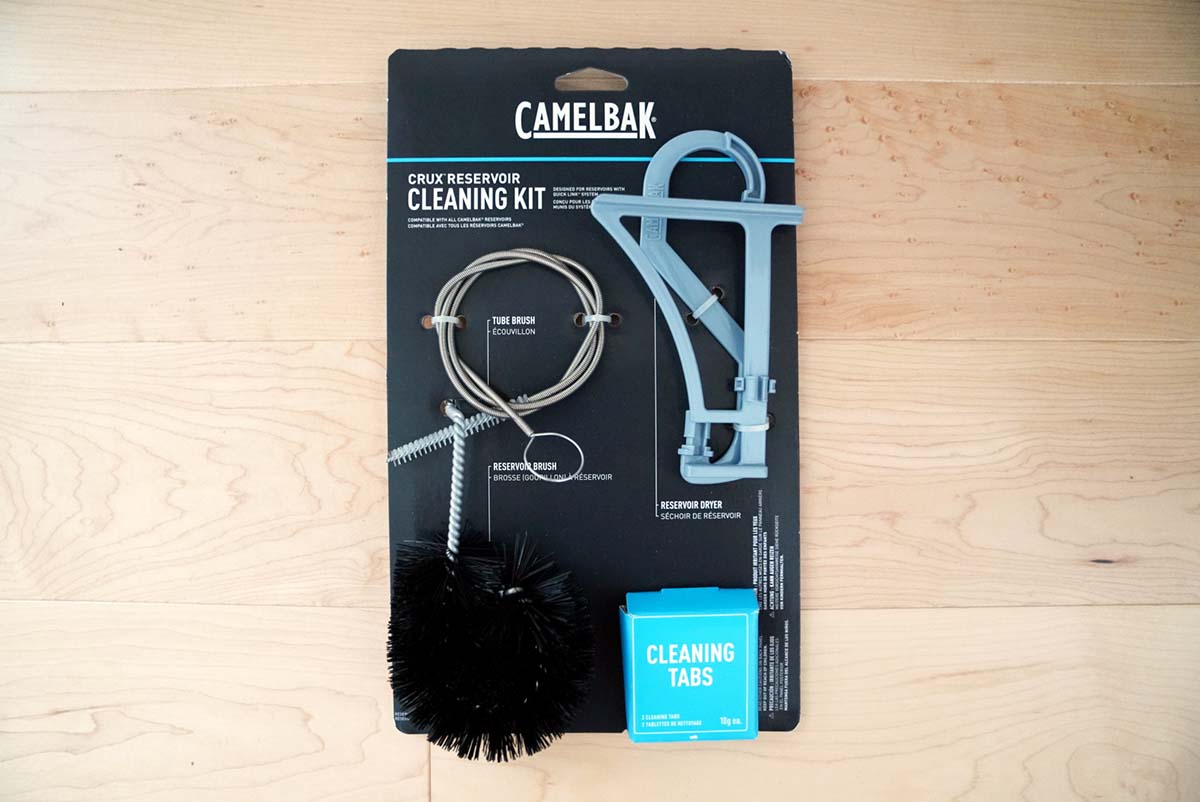
The hydration packs above range in capacity from the 1-liter CamelBak Hydrobak Light to the 34-liter Osprey Manta. What’s more, many designs are available in multiple capacities: The Osprey Skarab, for example, comes in 18, 22, and 30-liter models. We’ve found that anywhere in the 20- to 30-liter range is a sweet spot for an all-around daypack that can handle anything from local summits to full-day hikes. These packs generally feature well-rounded organizational systems (including a variety of zippered pockets), and ample suspension systems, but aren’t overbuilt or bulky.
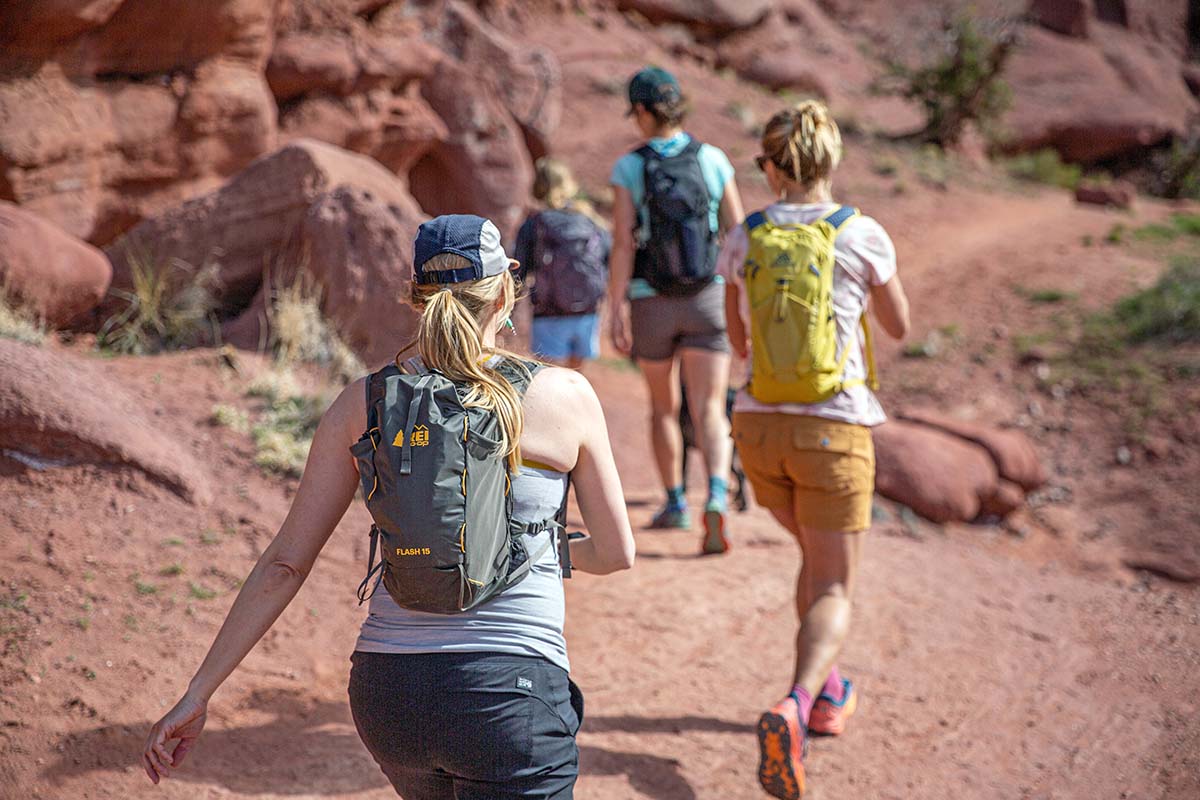
If you only need to pack an emergency rain jacket and a few snacks, you might be able to get away with one of the smaller packs above. These designs—like the Gregory Nano 18 H2O or Nathan TrailMix 2.0 12L—are easy to pack away in a larger pack or suitcase, and some crossover nicely to activities like mountain biking or mixed hiking and trail running, due to their streamlined nature and on-the-go storage. However, they’re not usually great all-rounder designs: On a recent day hike, we took Gregory’s Pace 6 H2O and had to store our sandwich and down jacket in our friend’s pack. On the other end of the spectrum, for gear-heavy adventures like winter hikes, a design like the Osprey Manta 34L features an impressive amount of storage, along with an adjustable and comfort-oriented suspension system. Below are some basic guidelines for capacity:
Short day hikes/multi-sport adventures: 5 to 18 liters
Average day hikes and everyday use: 18 to 30 liters
Long or gear-heavy day hikes: 30 to 40 liters
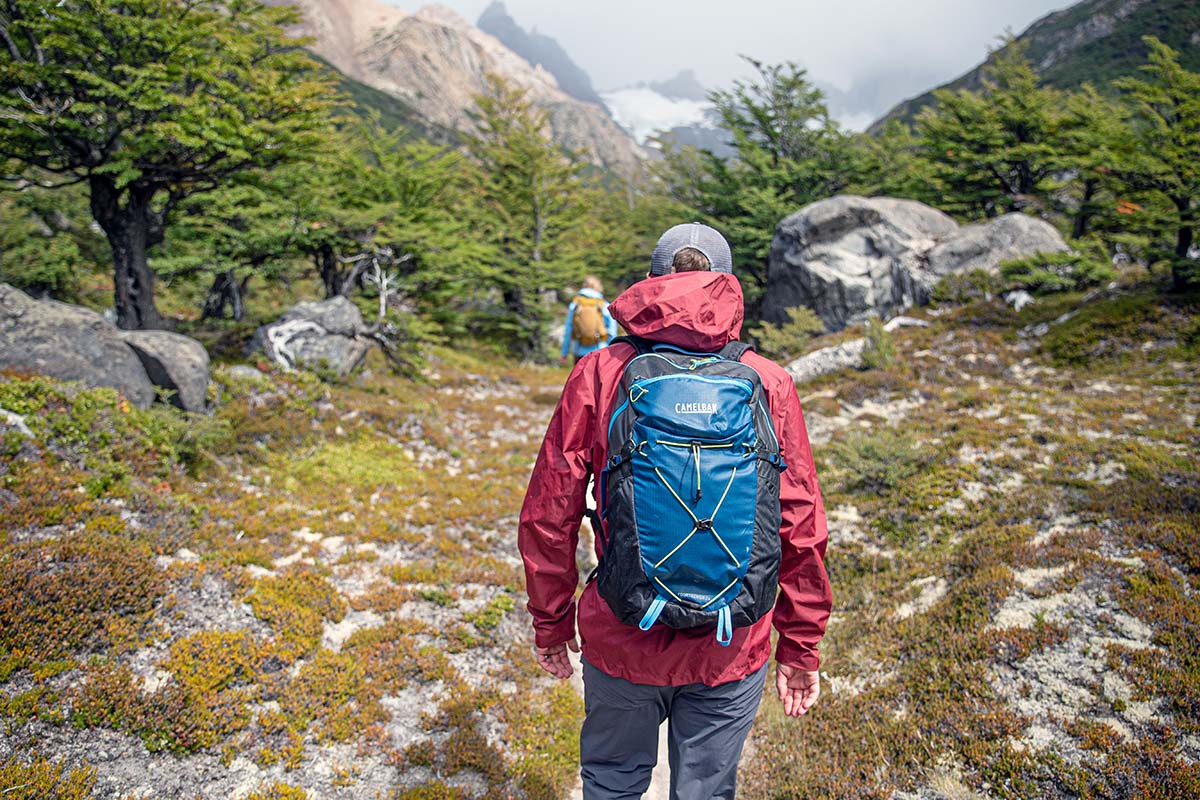
A quick look at our comparison table above reveals a wide range of pack weight from a scant 6 ounces to over 3 pounds (keep in mind, this does not include water weight). On the heavy end is the fully featured Osprey Manta 34, which comes with an almost ridiculous amount of pockets and external attachment points, along with a suspension system that rivals a backpacking pack. At the other end of the spectrum, packs like the REI Swiftland 5, CamelBak Hydrobak Light, and Nathan TrailMix 2.0 are minimalist designs with much less in the way of structure and capacity.
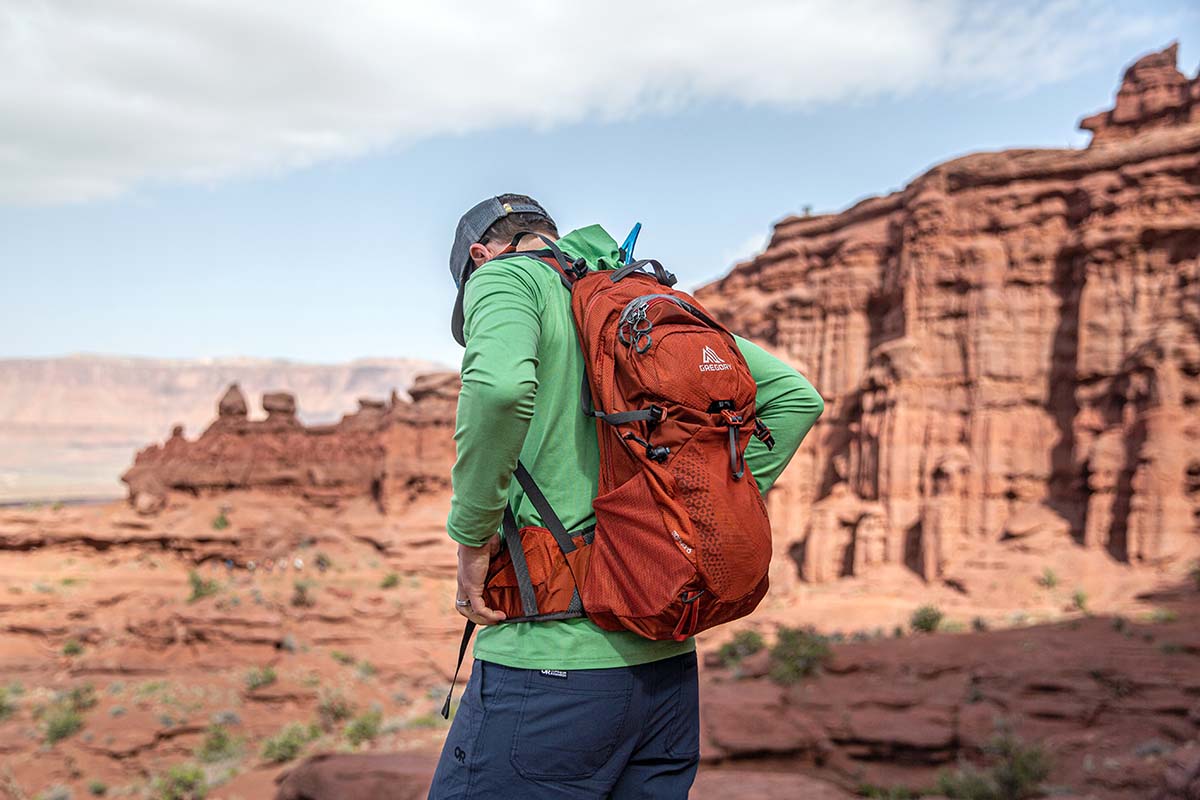
When evaluating pack weight, keep comfort and storage in mind. A fully featured pack will include padding on your back and real straps on your shoulders and waist to help distribute weight. If you’ll be carrying a heavy load, this will be your most comfortable option. But if you don’t mind feeling some of your gear on your back and keep your load relatively light (it is only a daypack, after all), the minimalist options on this list are more appropriate options (they’re also cheaper and far more compressible). In the end, most hikers and travelers will want something that lands in the middle and balances cushioning and weight, including the popular Osprey Skarab 30 (2 lb. 0.2 oz.) and Gregory Inertia 24 H2O (1 lb. 11.2 oz.).
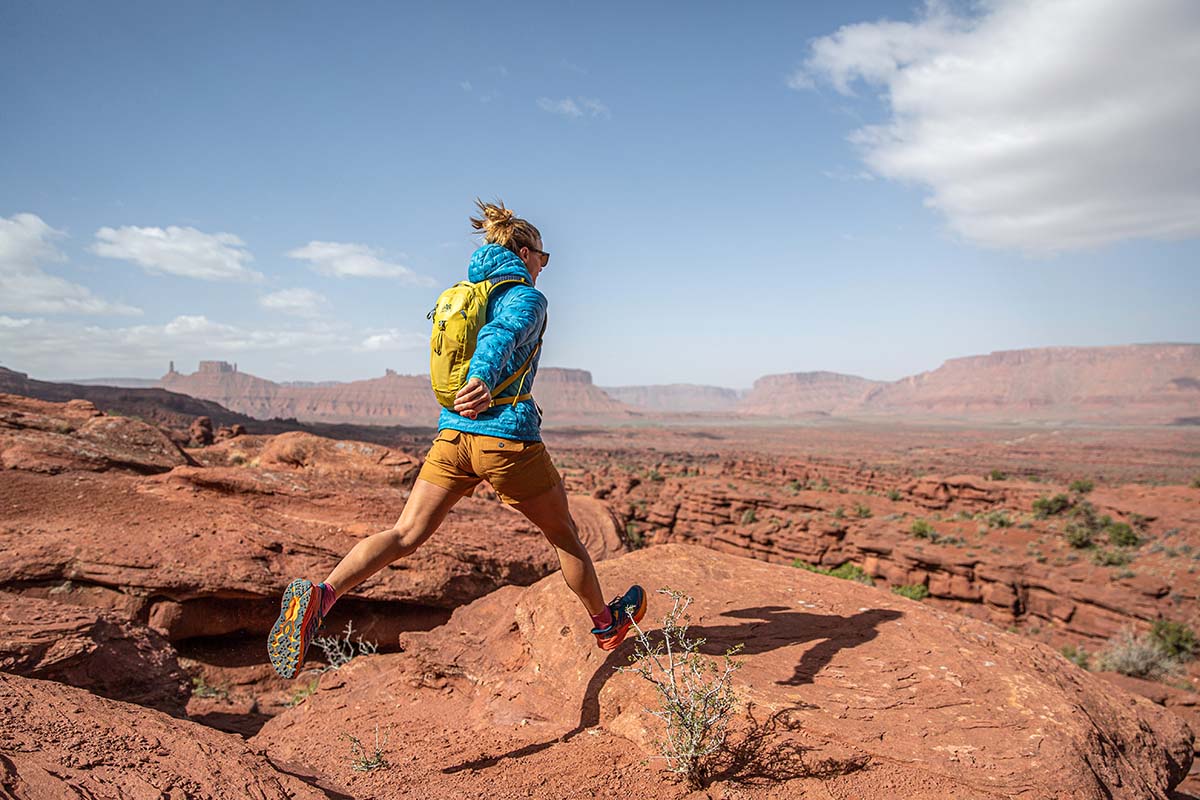
Reservoir Compatibility
Hydration packs include a range of features that make them more compatible with a hydration reservoir than a standard daypack, including tube ports, routing tabs, and magnets, easy-loading sleeves or dedicated pockets with hangers, and, every so often, insulated compartments for your water. These features lend a considerable amount of convenience and smooth operation, and are a key reason we might opt for a hydration pack over a daypack-hydration reservoir pairing. What’s more, it’s generally a bit cheaper to buy an all-in-one system rather than piecing your setup together, which is a nice bonus. Keep in mind that a more featured system generally translates to more weight and bulk, but the easy access to hydration can be well worth it.
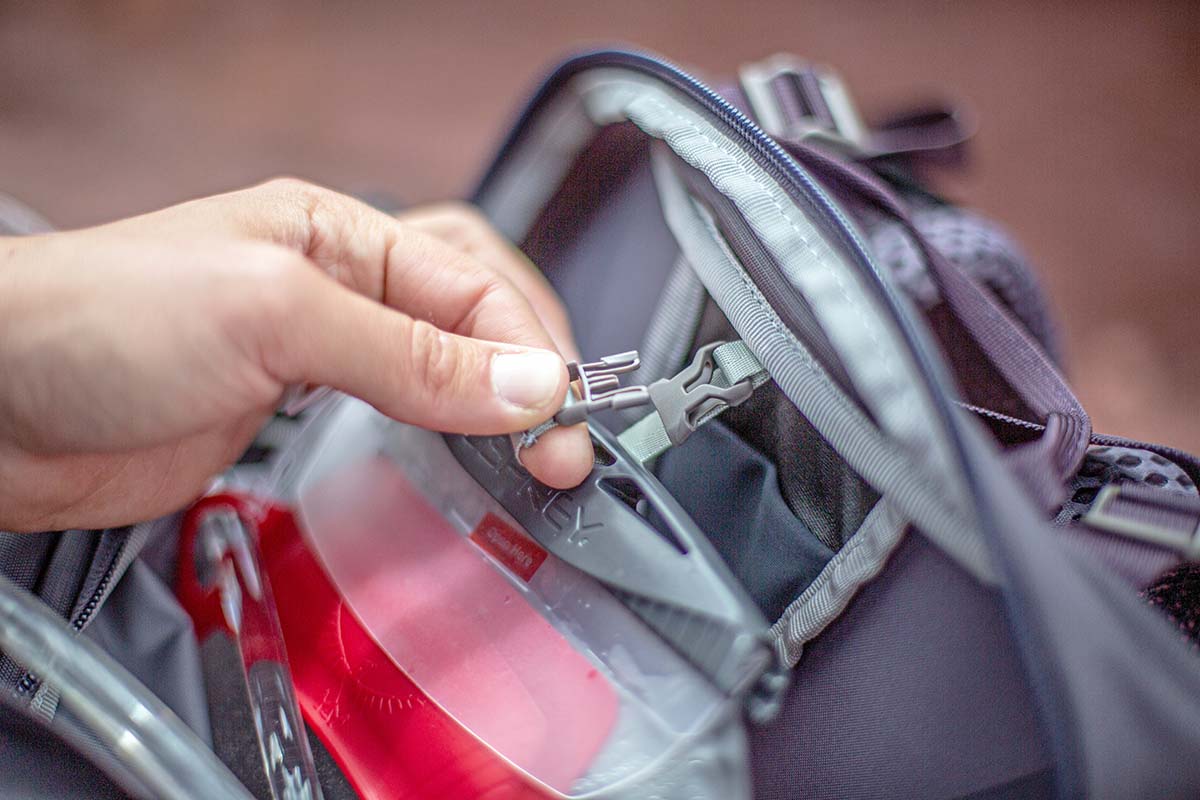
Backpanel and Ventilation
Like standard daypacks, hydration packs feature a range of backpanel designs for structure, load-bearing support, and ventilation. With the most minimalist packs, the backpanel is made up of simple foam or padded mesh: you get little in the way of structure and protection, but these designs are sufficient for light loads and allow the pack to compress for stowing in a travel bag or backpacking pack. On the other hand, more robust suspensions feature rigid frame sheets, metal stays, or even suspended mesh backpanels for class-leading ventilation (as seen in the Gregory Citro 30). Ventilated designs do eat into the size and dimensions of the main compartment and are more expensive, but it’s worth it for some. In the end, we recommend that most hikers stick with a middle ground design like the Osprey Skarab 30, which features a rigid framesheet covered in a plush layer of EVA foam and open mesh for ventilation.
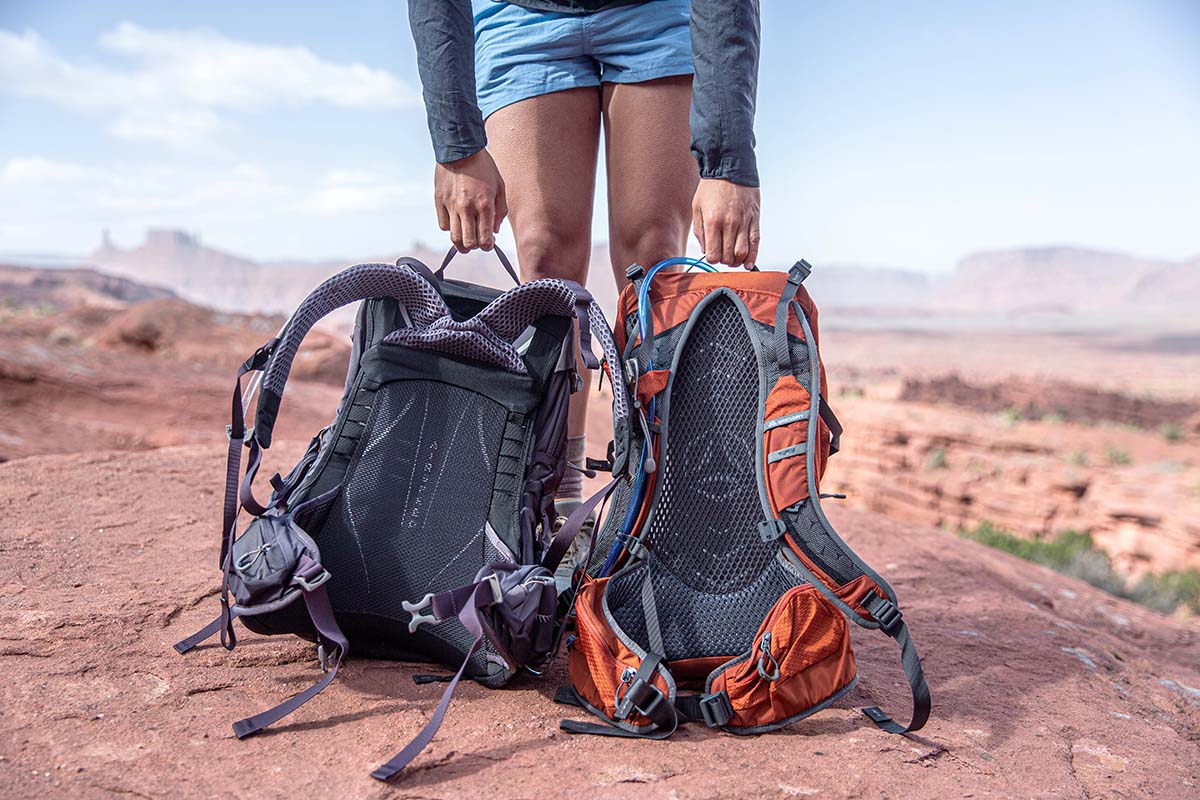
Pockets and Organization
If you like to have a defined space for (and easy access to) smaller items, look for a pack with a number of interior and exterior pockets. We like hipbelt pockets for things you want close at hand (beware, in most cases these don’t accommodate larger smartphones), an exterior pocket along the top lid for small items like a headlamp or energy bar, and a large, open main compartment for bulkier gear. Some of the running-inspired designs above (like the Nathan TrailMix 2.0 and CamelBak Octane 22) even feature storage on the front of the shoulder straps, which allows you to access food and essentials without removing your pack.
One of our favorite pack features is a large exterior mesh pocket along the front or sides of the pack, known as a “shove-it” pocket. This expandable space is great for items you may need quick access to (or want to dump quickly) like a rain jacket or snack. In addition, you can throw wet gear into this outer pocket to avoid soiling the contents of your main compartment. Minimalist designs omit many organization features—sometimes including the shove-it pocket—so keep an eye out for the number of internal and external pockets if those are important to you.
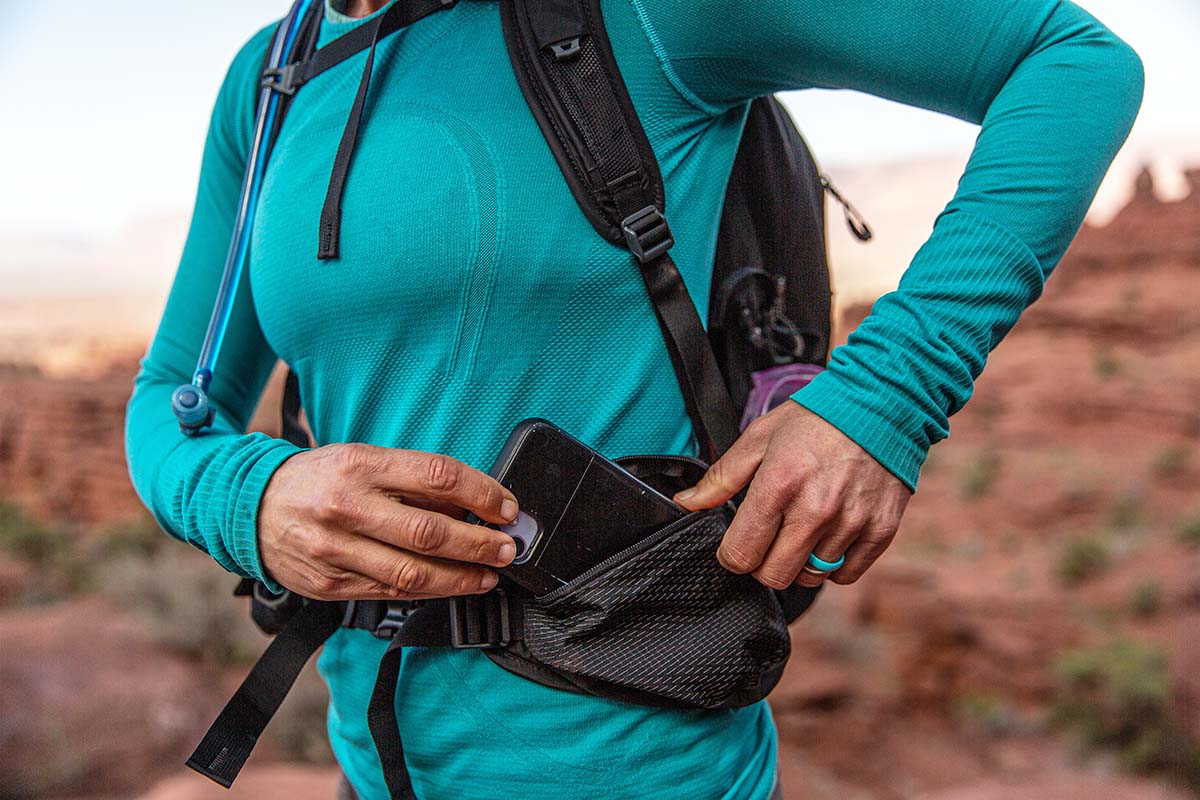
Closure Systems and Access
All of the hydration packs that made our list have access to the main compartment through the top of the pack, but the closure systems vary. Drawcord systems are popular on minimalist packs, while fully featured bags typically use zippers. We love bucket-style zippers like the Osprey Skarab’s, which create a large opening and allow you to easily see the contents at the bottom of your pack. Finally, some models, including the Nathan TrailMix 2.0 12L, use roll-top lids, which excel in versatility and allow you to adjust the volume of your pack to a changing load. In general, we prefer hydration packs that fully separate the main compartment from the reservoir storage, allowing you to organize your gear without a bulky bladder getting in the way.
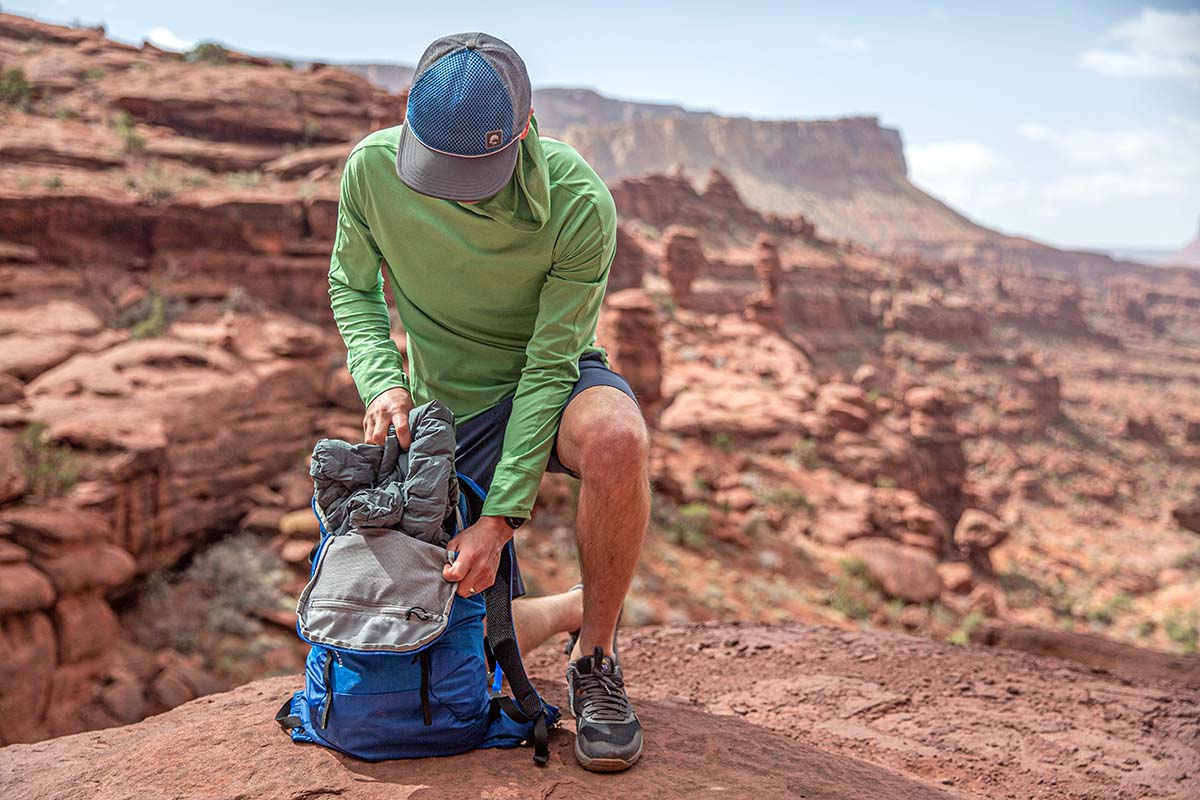
The amount of padding on the hipbelt and shoulder straps is a great indicator of a pack’s maximum comfort levels. Nearly all hydration packs have a hipbelt, but they vary from thin webbing (like the Gregory Nano 18 H2O) to cushioned and supportive (the Osprey Manta 34). If all you need is a pack for short day hikes and don’t plan on carrying more than 10 or so pounds, the thinner webbing is sufficient. If, however, comfort reigns supreme or you plan to haul a lot of weight, we highly recommend a pack with a real hipbelt. Keep in mind, the thicker designs don’t compress very well and do add some extra weight.
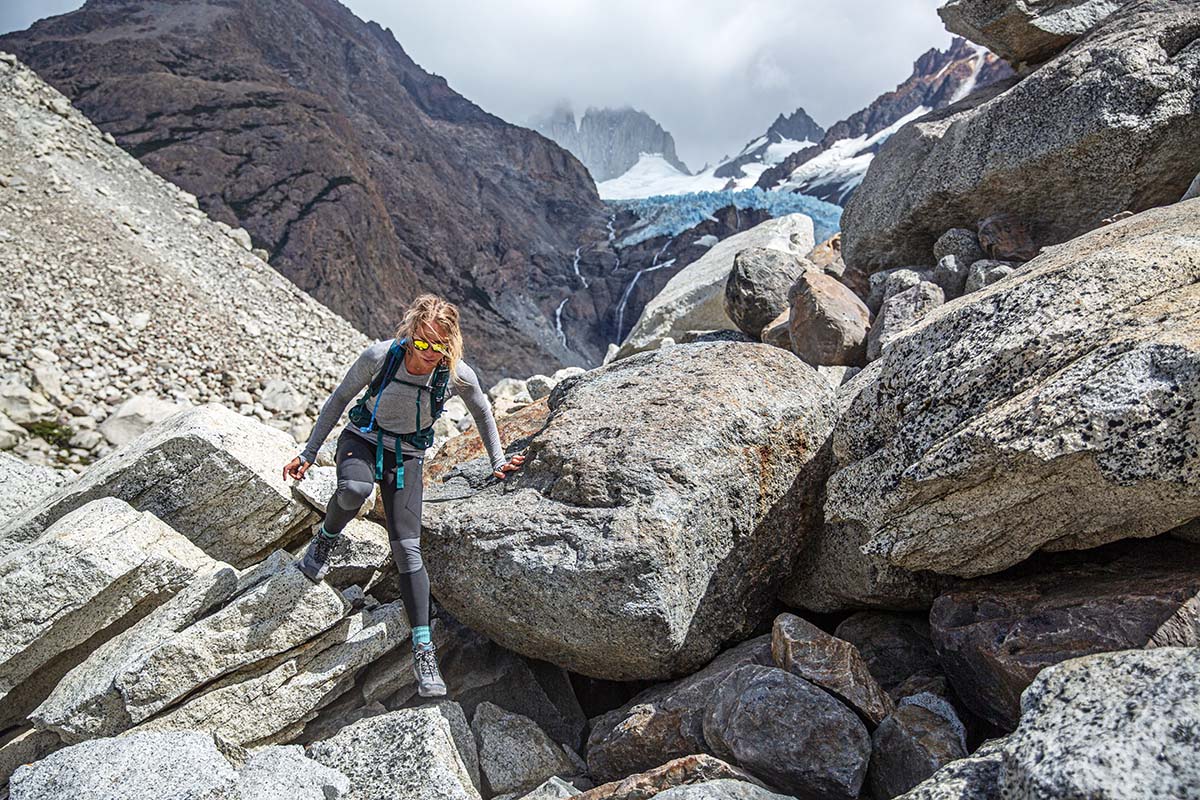
We should also note that there are a few running-inspired designs on our list above that forgo the hipbelt completely. These hydration packs—the Nathan TrailMix 2.0 12L and REI Swiftland 5 are two of our favorites—feature a vest-style sternum strap system, ride high on the back and close to the body, and are great for minimal loads and those going particularly fast and light. However, these are specialized designs, and we don’t recommend them for the average day hiker in the market for a hydration pack.
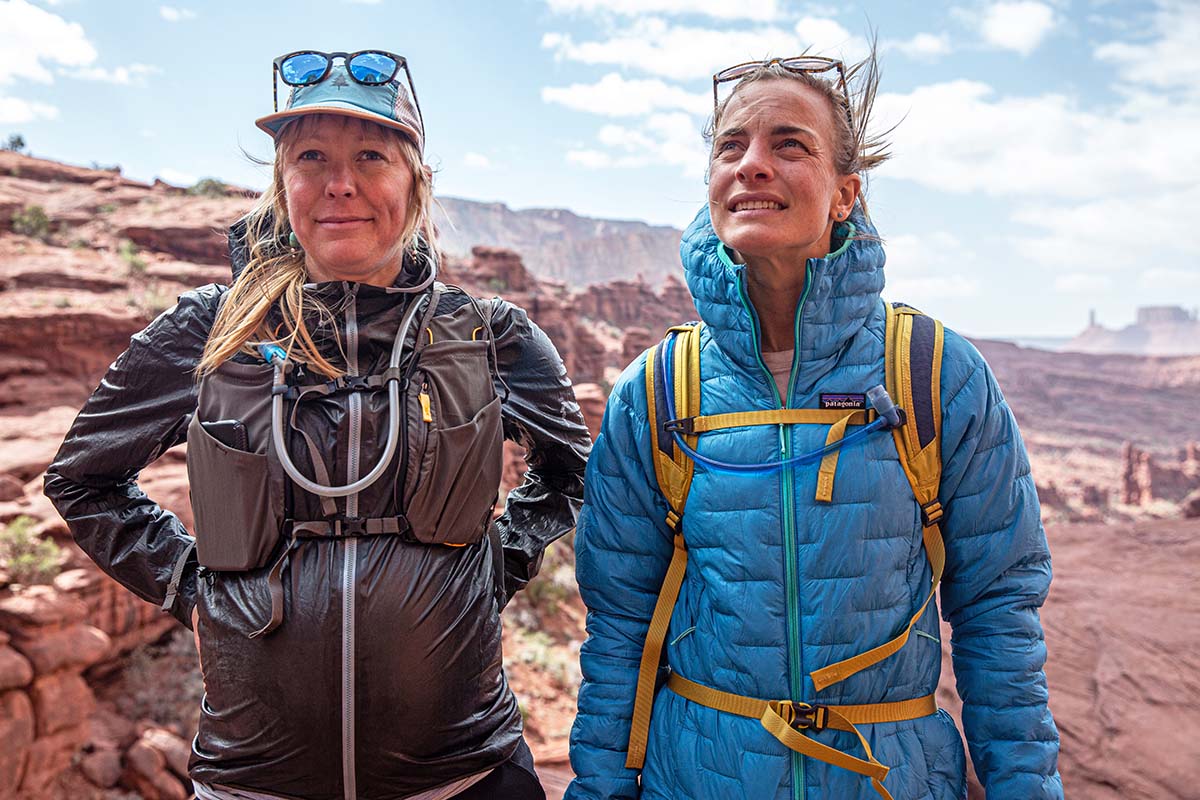
In addition to the amount of padding along the shoulder straps and hipbelt, fit plays a large role in overall comfort on the trail. Most importantly, you’ll want to ensure that your pack is the appropriate size for your torso length and that the hipbelt can be tightened to secure snugly around your hips. This can be a bit of a challenge with hydration packs: Most of the models above are only offered in a one-size-fits-all option. You do get the choice between men’s and women’s versions (the latter of which generally accommodate shorter torso lengths), but fit can nevertheless be a key reason that hikers might opt for a standard daypack (most are available in at least two sizes) over a hydration pack.
There are a few outliers that are worth mentioning here: Gregory Citro 30 and Juno 30 are both available in a plus size, and the Osprey Manta (and women’s Mira) features an adjustable harness that can be raised or lowered up to 4 inches. If you need a pack size that’s on the smaller or larger end of the spectrum, these are great options to consider.
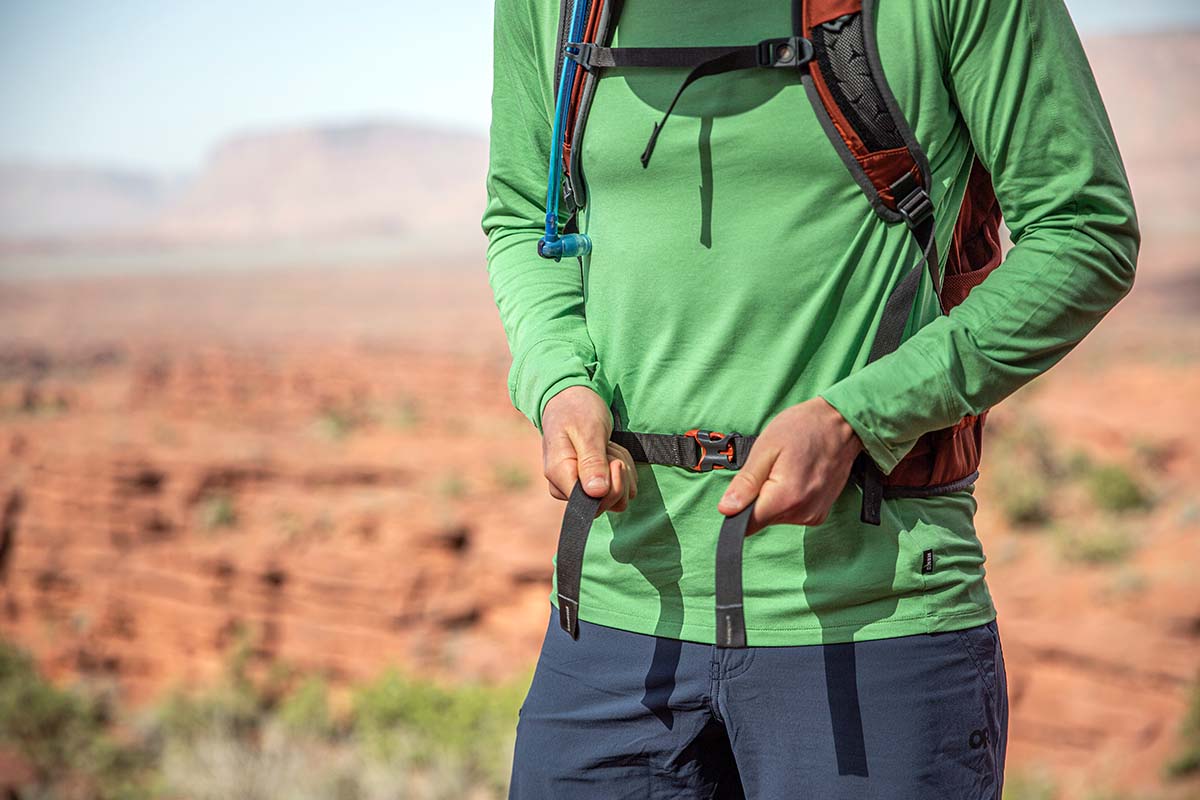
We appreciate when brands go the extra mile in creating environmentally conscious products, and the good news is that sustainability is a growing focus in the outdoor gear and apparel spaces. In the case of hydration packs, the most common measures we see are recycled fabrics and bluesign-approved materials, the latter of which indicates that the product meets strict chemical safety standards and has been built to minimize impacts on the environment. We’re also seeing a lot more PFC/PFAS-free durable water repellent (DWR) finishes on hydration packs, which forego the use of per- or polyfluorinated chemicals—“forever chemicals” known to be harmful to the environment. Finally, environmentally conscious shoppers can consider buying from a Climate Neutral Certified brand like REI that has worked extensively to reduce and ultimately offset their carbon emissions.
This article focuses on hydration packs specifically built for hiking, but there are a wide variety of designs for everything from mountain biking to trail running and resort skiing. Running hydration packs and vests generally range from 1.5 to 12 liters, prioritize a streamlined design that sits high on the torso and rides as an extension of the body, and feature accessible storage both on the front and the back of the pack. Mountain bike hydration packs, on the other hand, are similar to hiking designs but tend to be lower-profile and smaller in capacity, with a range of bike-specific features, including helmet and bike light attachments and reflective patches. Finally, snow-specific hydration packs use insulated reservoir sleeves and tubes and bite valve covers to keep your water from turning into ice.
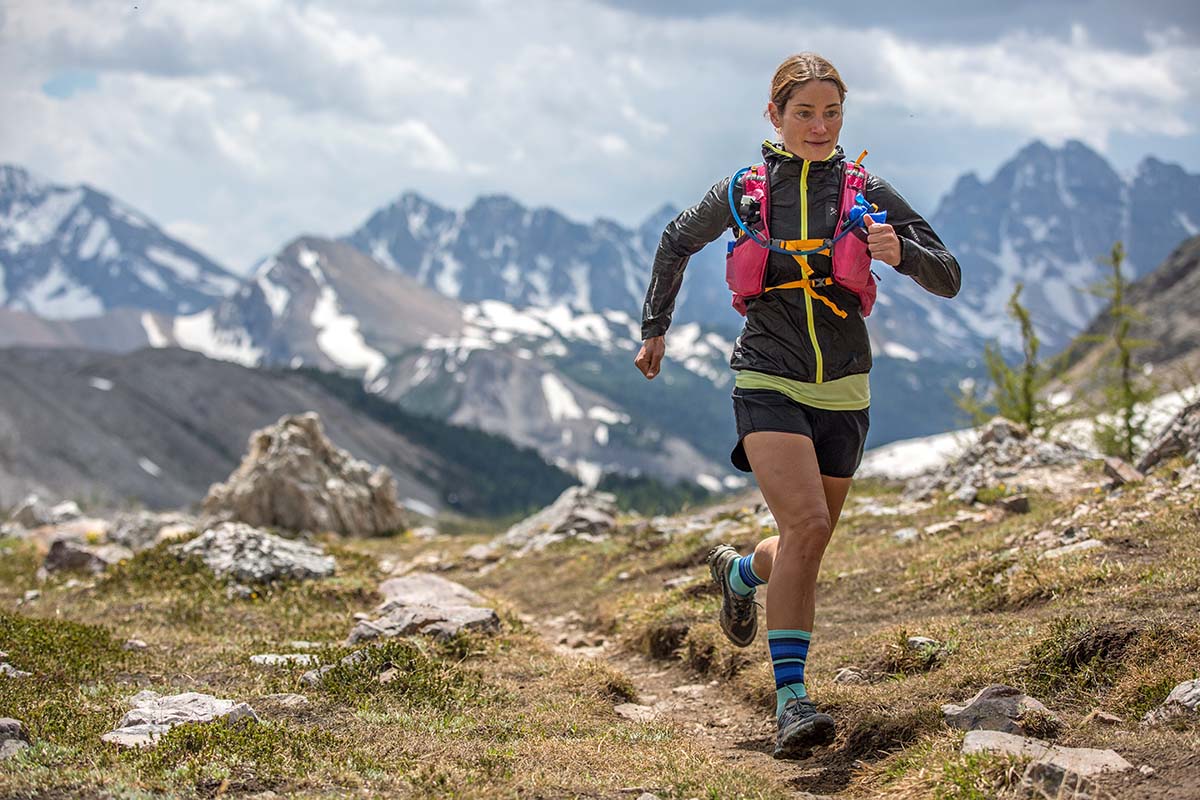
If you participate in more than one sport, chances are that you own more than one hydration pack. The differences can feel rather minor—after all, all of these designs are built to carry gear and offer convenient hydration—but we’ve found that the purpose-built models can go a long way in terms of comfort and convenience. That said, there are a few multi-sport models to be aware of, including the CamelBak Octane 16 and the Nathan TrailMix 2.0 12L. Both of these packs feature fairly lightweight builds and on-the-go storage without being too polarizing in any direction. If you’re looking for a quiver-of-one hydration pack for casual hiking, mountain biking, and trail running, they’re certainly worth a second look.
Hydration Waist Packs
Last but not least, hydration waist packs offer a low-profile storage solution for short outings. Typically designed for activities like mountain biking or running, many hydration-equipped models cross over well for hiking, including Osprey’s Seral 4 above. In addition to being light and streamlined, the Seral keeps your back free (great on hot days) and focuses the weight on your hips (there’s nothing worse than a sore collarbone from an ill-fitting pack). As for downsides, waist packs have limited capacity compared to standard packs (typically around 2 to 7L) and use smaller reservoirs (1.5L is standard, and many running designs use bottles instead). Many also include sport-specific features—like the Seral’s bike light attachment and tool compartment—although this can be a plus for those who plan to use their pack for multiple activities. For exclusively hiking, there are several non-hydration-equipped options available (we include some of our favorites in our fanny pack round-up), although most require supplying your own bladder or bottles.
Back to Our Top Hydration Pack Picks Back to Our Hydration Pack Comparison Table